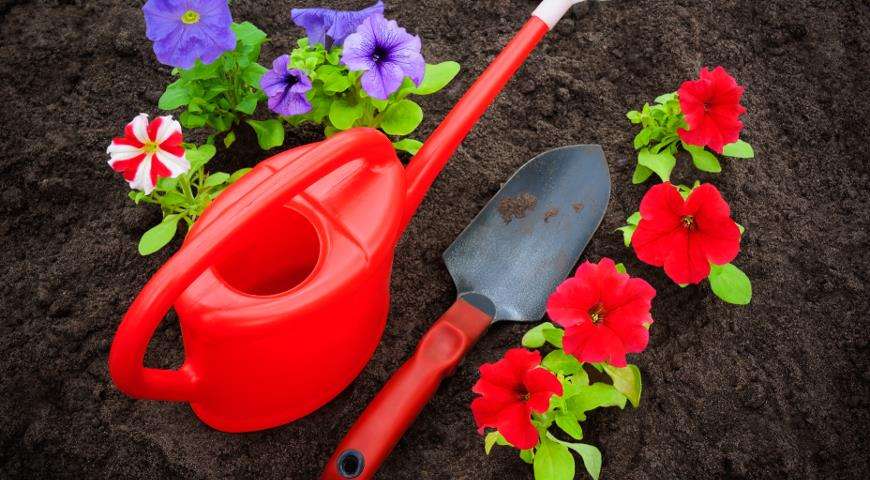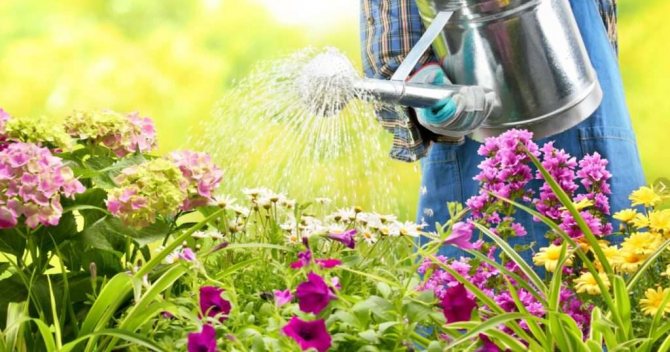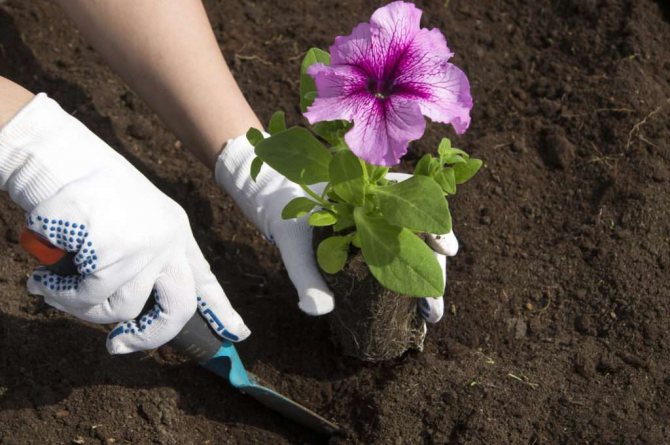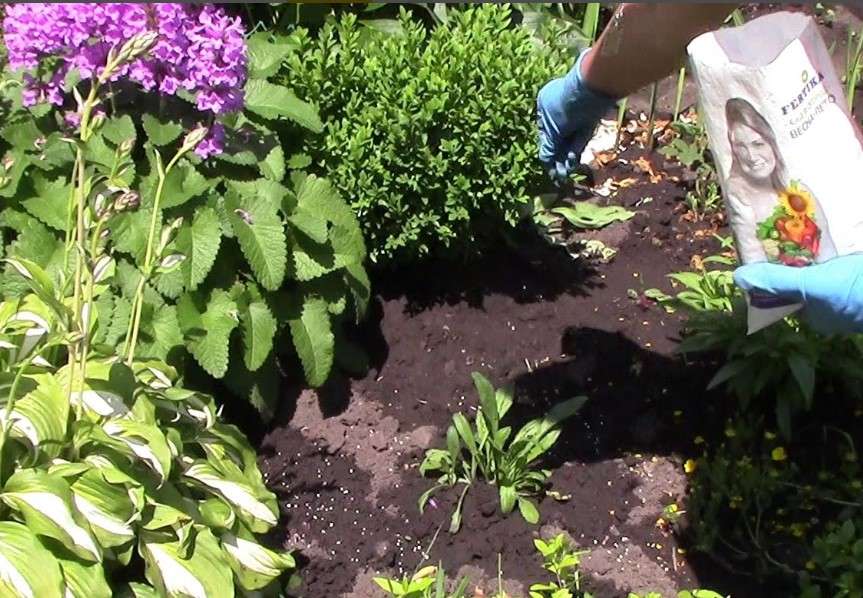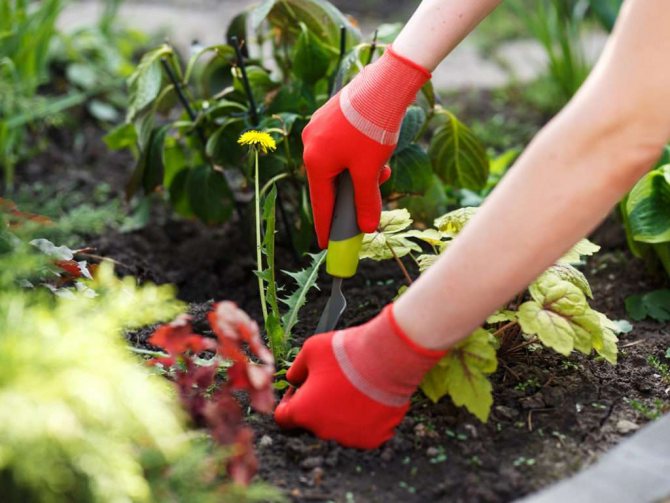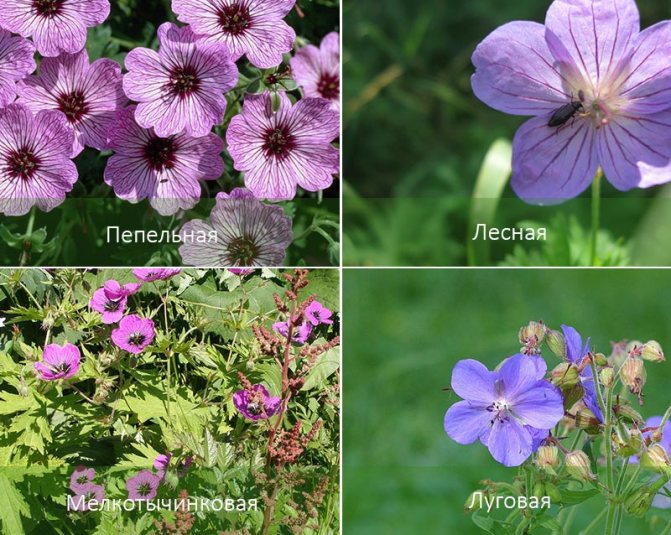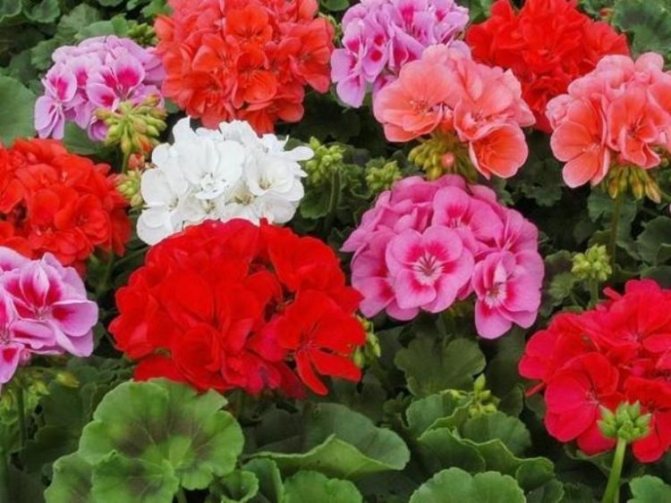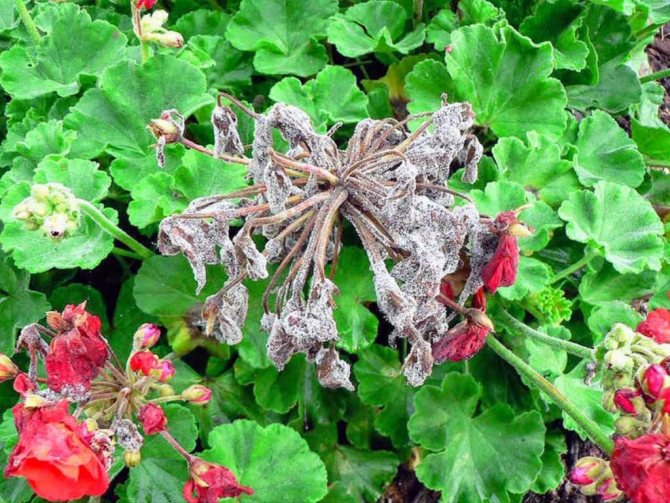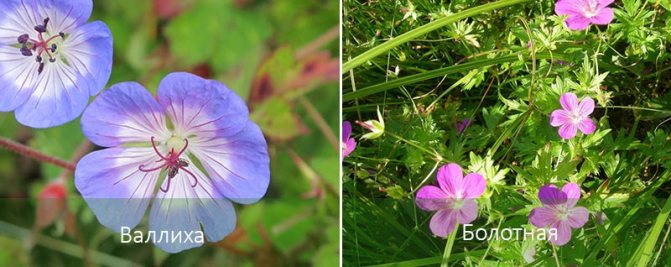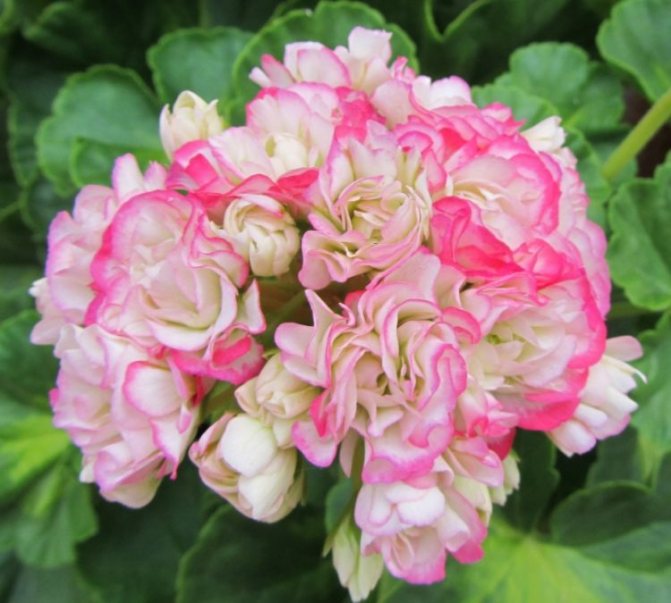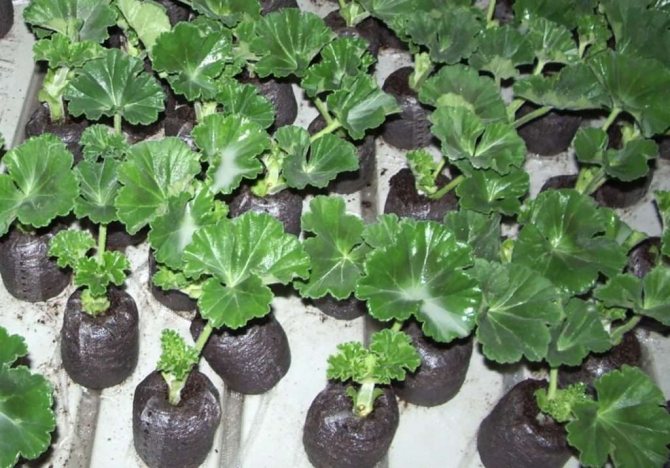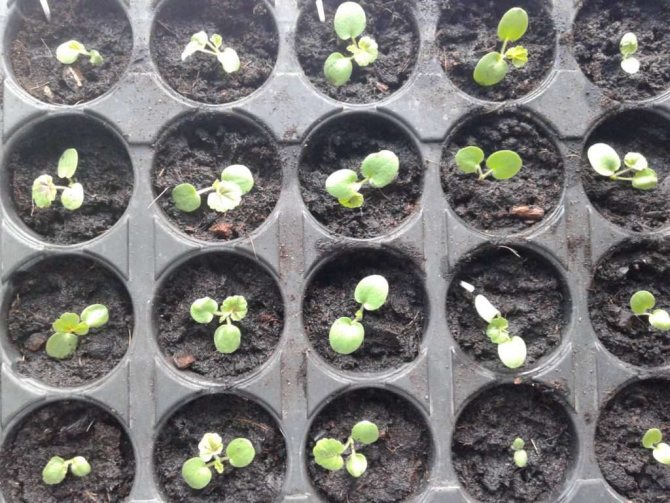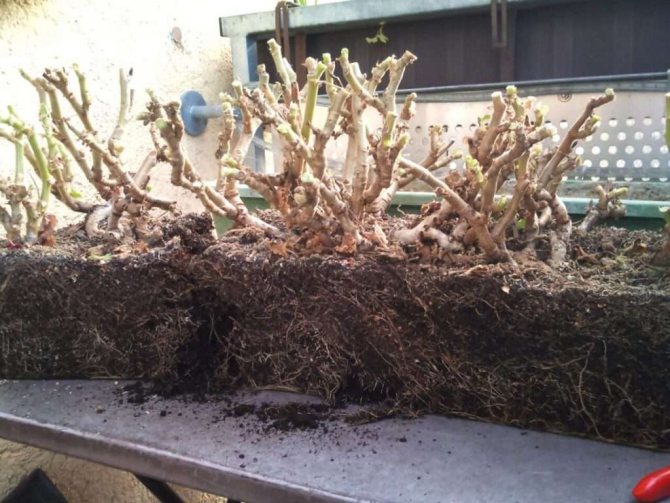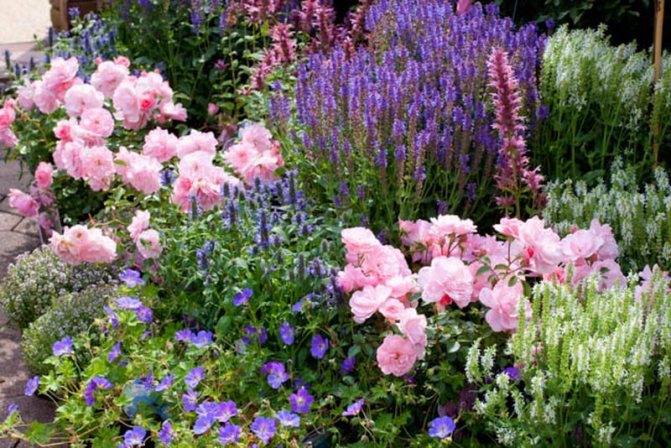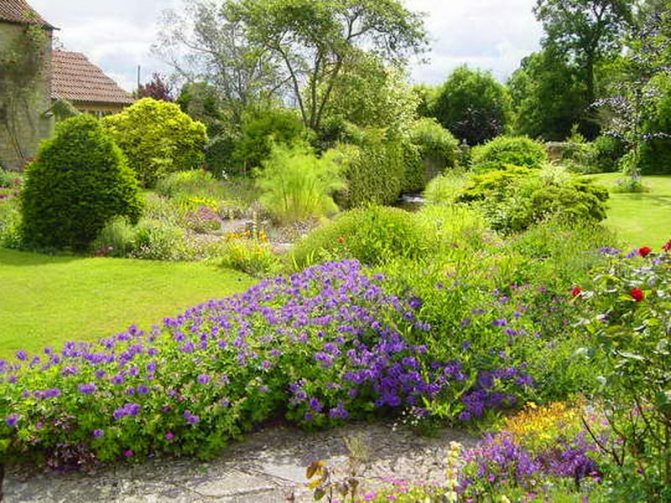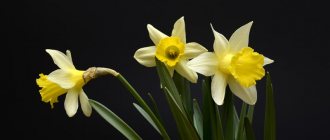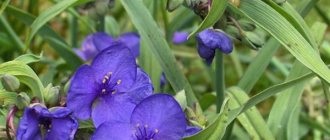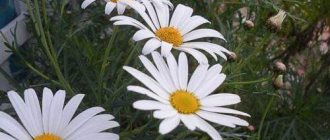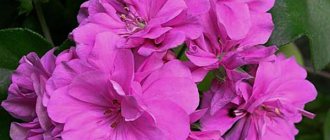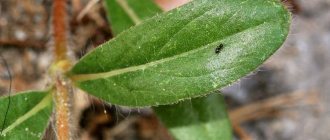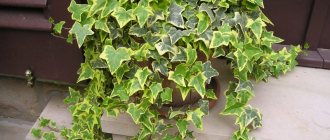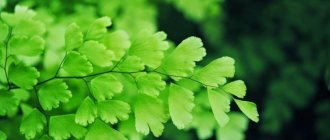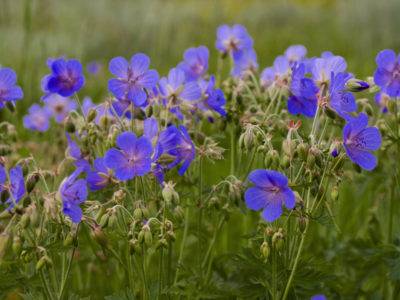
Field geranium is a true natural doctor. The healing properties of this plant are widely used in folk medicine to fight a number of diseases.
This type of plant is also called the crane. The crane grows on the edges of coniferous and deciduous forests.
Field geraniums often spread in glades, meadows, along river banks and along fences. It is also planted by amateur gardeners in their summer cottages. It is found in the European part of Russia, in Western Siberia and in Central Asia.
- What is a crane?
- Chemical composition and pharmacological action
- Use for diseases
- Application - recipes, instructions
- Contraindications
The difference between garden geranium and room geranium (pelargonium)
There are many differences between pelargonium (room geranium) and real geranium, although they belong to the same family. South Africa is considered the birthplace of pelargonium. Countries with a temperate climate are considered the homeland of geraniums - the Mediterranean coast, the forests of Belarus, the mountainous regions of the Caucasus, Central Asia, some regions of Siberia and the Far East.
Geranium can tolerate frost, grows well in open ground without digging up for the winter. Pelargonium is an indoor flower, if it is planted in the ground, then only in the summer, and in the winter it must be dug up and transferred to winter indoors.


Geranium seeds look like the nose of a crane, which is probably why the plant was named with a word that translated from Greek means "crane" (geranios). But Pelargonium in translation from the same Greek means "stork" (Pelargonium). Just as the stork and the crane belong to the same family, so the geranium with pelargonium is a genus of geraniums.
Karl Linnaeus combined these two plants into one group. Until 1738, these plants were not combined into one genus, but it was during these years that pelargonium (and everyone knew it as geranium) gained insane popularity among the British. It was actively used in landscape design, the creation of famous gardens in the English style, and the famous naturalist decided to combine these two species into one genus.
Despite the fact that geranium and pelargonium are members of the same genus, along with the similarities between them there are many differences. The most important confirmation that these are different plants is that they do not interbreed.


They have flowers and leaves of different shapes. Geranium flowers are most often single inflorescences, consisting of 1-5 flowers. Pelargonium has large umbrella-type inflorescences of flowers of irregular geometric shape.
Geranium is beautiful not only for its flowers, but also for its leaves. Large in size, unusual in shape leaves (palmate or palmate) go well with beautiful flowers.
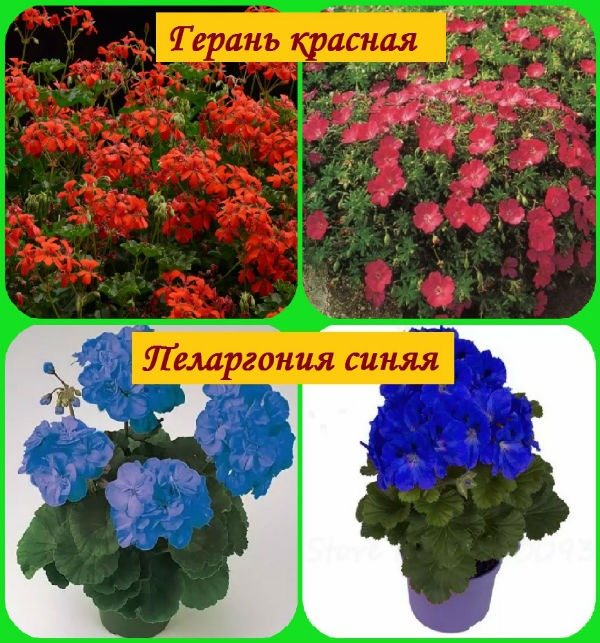

Geranium does not have red flowers, and pelargonium does not have blue flowers. Although it must be said that the efforts of modern breeders have bred varieties with such a color of flowers.
Below is a small comparison table of geranium and pelargonium.


Collection and storage
The medicinal raw material is mainly the ground part of the plant, less often the roots. Herbaceous parts (leaves, flowers) are harvested during flowering. To enhance the healing effect, it is recommended to collect the herb in the morning in sunny weather, after the dew has melted. It was at this time that the maximum concentration of nutrients was noted in it.
Dry the grass under a canopy or in a room with good ventilation. Can also be dried in an electric dryer at 40–45 ° C. The roots are dug up in the fall, shortly before the dormant period for the geranium. They are cleaned of earth, washed thoroughly, then dried and stored in whole or crushed form. The shelf life of raw materials in glass or wooden containers is no more than 1 year.
Geranium species and varieties with photos
Garden or real geranium, unlike its unlikely sister, pelargonium, was not so popular among gardeners. The reason for this unpopularity was not very large flowers, heavily carved leaves. But recently, the popularity of garden geraniums has increased many times over, because in a group design, this shrub looks just great. Due to its qualities - frost resistance, unpretentious care, it has become very popular in landscape design.
There are about 400 species of geraniums in nature. On the territory of Russia, the following types are most often found:
- large-rhizome crane
- dark-brown crane
- southern European crane
- fluffy geranium
In the European part of the world, shrubs began to be used in decorating gardens from about the 17th century, and in Russia they learned about it a century later - in the 18th century. Only after some plant species were discovered in the Caucasus (this happened in the 19th century), a more dense, concrete study and use of it in landscape construction began.
Conventionally, geranium is divided into undersized and tall plants.
Tall ones grow more than 50 centimeters, respectively, undersized varieties - up to 50 centimeters.
Botanical description and history of origin
Geranium belongs to the Geraniaceae family. Is not only a horticultural crop, but also grows in the wild wherever the climate is temperate. There are about 400 types of geraniums distributed around the world.
For example:
- on the coast of the Mediterranean Sea, in the highlands on the rocky slopes of the mountains, the geranium "Krupnokornevischnaya" grows;
- in the mixed forests of Belarus - "Blood-red" (more about blood-red geranium can be found here);
- in Central Asia (except for deserts), in the Caucasus and southern Europe - "Kholmovaya";
- in the upper reaches of the Siberian river Lena, in Dauria, Sayan and on the coast of Lake Baikal - "Belotsvetkovaya";
- in Siberia along the Selenga River, In Dauria, on the Vitim and Baikal uplands, as well as along the upper reaches of the Lena - "Geran 'Vlasova".
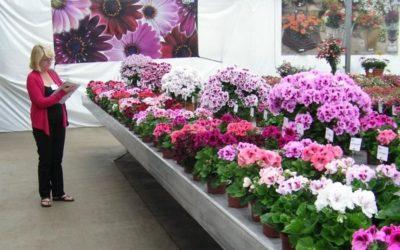

Geraniums are native to the southern regions of England... And most of the varieties are bred by English and Dutch breeders.
Garden geraniums are used in landscaping. In addition to ornamental flowers and leaves, this perennial herb is resistant to low temperatures and requires minimal maintenance. Therefore, it is popular with many gardeners.
Geranium is a ground cover crop that covers the earth with a beautiful carpet due to the fact that its root system develops in width, not in depth. In addition to bright blooming planting geraniums is useful as a protective effect for the earth, prevents soil erosion and drying out.
Marsh geranium
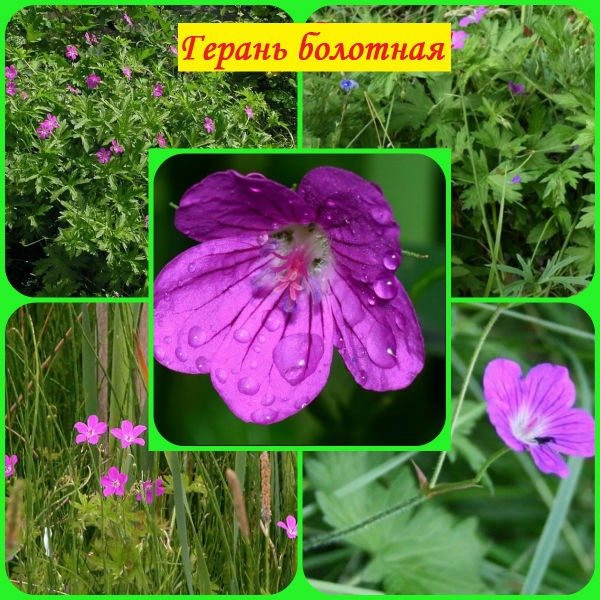

Marsh geranium can grow up to 30-70 centimeters. The plant is perennial, the rhizome is ascending (short, ascending to the growth of the plant, has the ability to branch). On one peduncle there can be 2-3 large (up to 4 cm in diameter) flowers. The color of the flowers is purple. Flowering time June-July months. Grows in forests, wet meadows, swampy areas. It can be found in Belarus, Ukraine, the Caucasus and the entire European part of Russia.
In landscape design, it looks best in mixed flower beds.
Possesses a number of useful healing properties:
- normalizes heart rate
- helps with colic of various origins
- helps with hearing impairment and ear pain
- rheumatism, gout, dysentery, urolithiasis
Chemical composition and pharmacological action
The roots of the plant include:
- saponins;
- phenol carboxylic acid;
- tannins;
- flavonoids;
- catechins;
- carotene;
- vitamin C;
- carbohydrates.
Field geranium herb contains:
- Glucose.
- Raffinose.
- Fructose.
- Alkaloids.
- Saponins.
- Vitamins K and C.
- Carbohydrates.
- Carotene.
- Flavonoids.
- Tannins.
- Leukoanthocyanins.
- Anthocyanins.
- Minerals:
- manganese;
- iron;
- zinc;
- nickel.
Meadow geranium has numerous pharmacological properties:
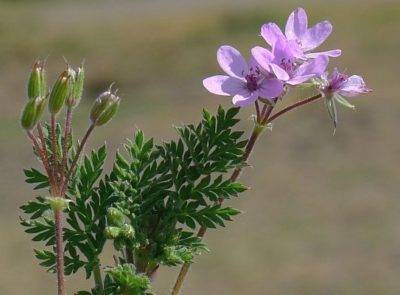

astringent;- anti-inflammatory;
- disinfectant;
- antibacterial;
- wound healing;
- antitoxic;
- hemostatic;
- calming;
- antipruritic;
- antipyretic;
- relaxing;
- pain reliever.
In addition, the plant is able to dissolve salt deposits in gout, rheumatism and kidney stones.
Geranium gorgeous
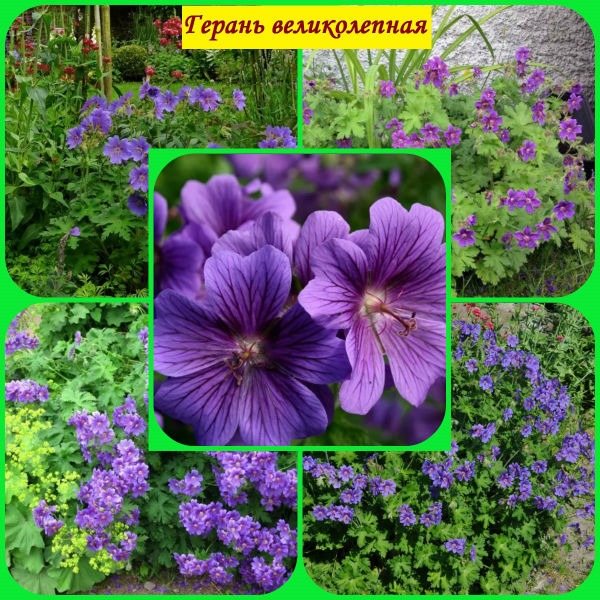

This plant lives up to its name. The lush bush can reach a height of 60 centimeters. Large flowers of various shades of blue can form small inflorescences of 2-3 flowers. There can be up to three inflorescences on one branch. Geranium blooms magnificent from June to the end of summer, subject to proper care.
The leaves are serrated, dissected into five parts, slightly pubescent. In the fall, the leaves turn from green to terracotta or other shades of red. Thanks to this, even after the flowers have faded, it fully justifies its name.
On the basis of gorgeous geranium, many different varieties have been created. The most popular varieties are described below.


Alan mayes The shape of the bush is a hemisphere. Compact dimensions - 40 cm high, 35 cm wide. The flowers are deep blue with small black veins.


Blue blood It has a dense regular bush about 35 cm in diameter. The flowers are large enough (4.5 cm). The color is from blue to violet-blue, the center of the flower is light. Suitable for decorating flower beds, decorating paths.


Mrs. Kendall clark The plant is perennial, the bush reaches a height of one meter. It grows and develops best in sunny places, but feels great in partial shade. It is not recommended to plant in places where there is stagnant moisture. The flowers are blue-violet with white or blue veins.
The average diameter of the flower is from 3 to 3.5 cm. It blooms profusely, for a long time (from June to the end of summer). Perfect for decorating perimeters, paths, flower beds.


Rosemoor A dense bush (up to 0.60 meters). The best place to land is a sunny spot. But even in partial shade it grows well, blooms profusely. Large-sized flowers (up to 5 cm in diameter) are violet-blue, the center of the flower, lilac-pink. Against this background, the veins of a dark blue color stand out beautifully. Flowering time - June - July. After flowering, it has an equally attractive appearance due to its leaves.
Leaves are palmate - dissected, bright green, slightly pubescent. In autumn they acquire a brick or orange color. It goes well with loosestrife, meadowsweet, cuff, sage. Ideally combined with plants with shades of blue flowers, such as Fassen's catnip and Veronicastum Virginia Cupid.
Great for decorating the edge of flower beds or decorating a flower bed.
Contraindications
In the use of funds based on geranium, field contraindications are in the following cases:
- increased blood viscosity;
- thrombosis;
- thrombophlebitis;
- senile constipation;
- intestinal atony;
- gastritis with high acidity.
Field geranium has a variety of medicinal properties. The beneficial qualities of this plant have found application in numerous recipes for traditional medicine. Before using products based on meadow geranium, it is very important to familiarize yourself with the contraindications.
When treating with drugs intended for internal use, it is necessary to observe the exact dosages.
dacha.expert
Geranium geranium


The main distribution area is the meadow Caucasus. Differs in its unpretentiousness. It grows in one place without a transplant for 10-12 years. The bush grows up to 70-80 centimeters in height. The foliage is slightly pubescent, has a beautiful greenish-gray color, the shape of the leaf plate is polygonal with a serrated edge. In the autumn months they take on a red hue and decorate the garden.
The flowers (4.5 cm) are purple, the veins are purple. It begins to bloom in mid-July to September. In landscape design, it is used to decorate flower beds, edges of paths, lawns. The rhizome can be used as a natural dye. It (rhizome) contains black dyes.
Growing and care
This wild perennial can really be grown in your own garden. In the spring or at the end of summer, you should find several geranium bushes in the forest or in a clearing, dig them up and transplant them into a bright place in the country (into moist, slightly acidic and fertile soil). After forming the planting hole, put a couple of AVA fertilizer crystals there. After transplanting geraniums, water for a while.
Reproduction of a plant is carried out by seeds collected in its natural habitat, followed by their sowing in winter. The flowering of seedlings should be expected in the second year. Then the culture will please with seeds and excellent self-seeding. Blooming geraniums from June will decorate any garden. When it is over, the bushes will require pruning so that the plant does not lose its decorative effect in the fall. During this period, the carved foliage is painted in an unusual raspberry-purple hue.
Geranium red - brown
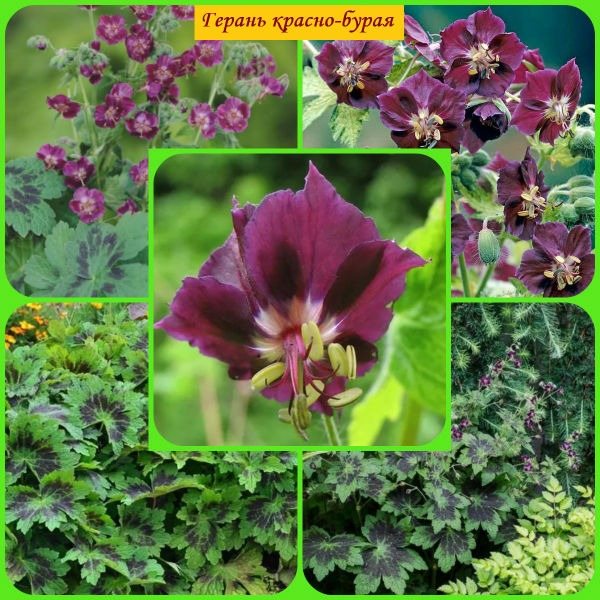

Originally from the forests of the Carpathians. Basal leaves can be very large - up to 10 centimeters wide. They have 5-7 shares. The color of the leaves has a bluish tint. by the middle of summer, purple lines appear on them, forming an original pattern. This color remains until the appearance of new spring leaves. Due to this property, red-brown geranium is popular among many gardeners. In height, this species can reach 0.80 meters.
The flowers are small - only 2 cm in diameter, have a dark purple-brown color. The edge of the flower has a slightly wavy shape. Geranium blooms in the month of July and August.
Appearance
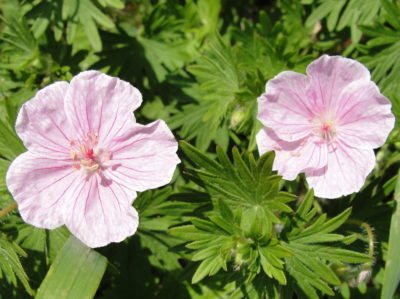

Herbaceous geranium - ground cover crop: its roots grow in width, not in depth. The diameter of its flower is 2.5 - 4.4 cm, the color of the flowers is very diverse: white, blue purple, etc. The leaves are covered with fine hairs, have a peculiar smell and varied color: green, grayish, bluish. Until the cold weather, the plant retains its decorative appearance due to the openwork foliage with pointed and rounded edges.
Geranium blood-red
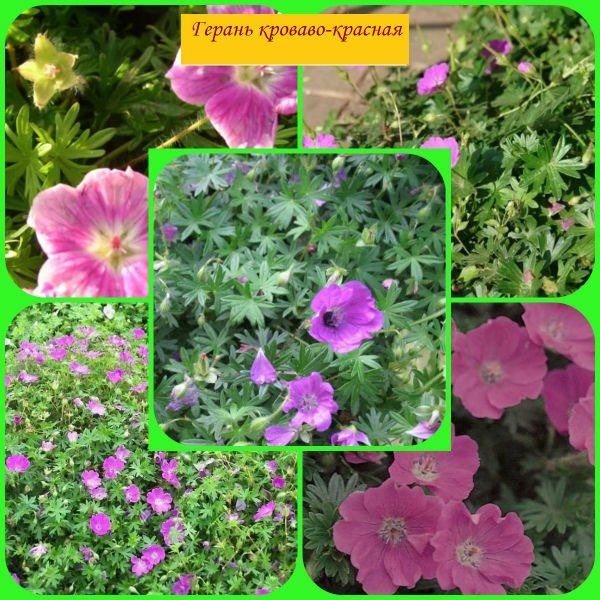

Blood-red geranium is common in the Balkan Peninsula, the Caucasus, central Europe and Russia. A hemispherical bush can grow up to 60 centimeters. The foliage is dense, the leaves are carved, palmate - separate. In autumn, part of the foliage acquires a red tint, and some can remain green until spring. Single large (up to 5 cm) flowers from light pink to purple color. Flowering time - June - August.
Blood red geranium varieties


Blood red geranium is often used in folk medicine. Extracts and extracts from rhizomes have an excellent antiviral effect, high antifungal, hemostatic, antiseptic and antimicrobial properties.
Infusions of the plant are used for diarrhea, gout, urolithiasis. Decoction can be used to rinse the mouth with bleeding gums, wash the wounds.
Breeding features
For reproduction of geraniums use:
- rhizome;
- seeds;
- cuttings.
Rhizome


Dug out the rhizome of an adult plant is divided into parts and immediately planted in the ground or they can be stored in a container with sand in a cool place until spring.
Seeds
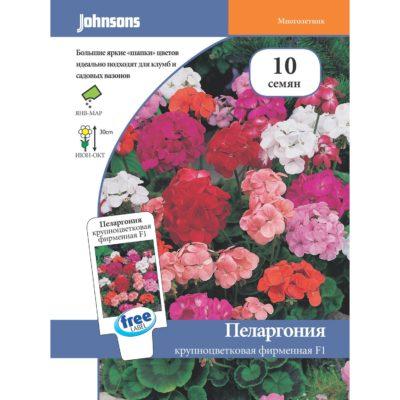

Garden geraniums are rarely propagated by seeds.It is believed to be the method for experienced gardeners. But the main reason is that seedlings grown from seeds bloom only the next year.
Forest geranium
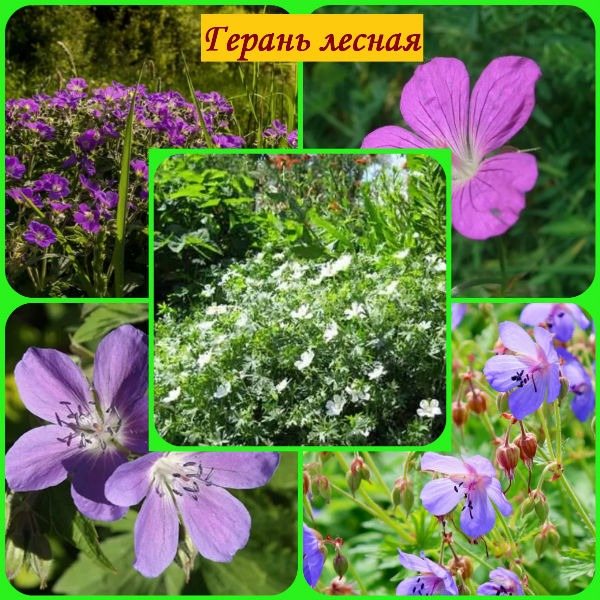

Often found in Western Siberia, meadows and forests of Europe, can be found in Central Asia. The bush grows up to 0.70-0.80 meters. Semidolate leaves with large denticles, slightly pubescent.
The most common flower color is purple or lilac. The flowering period is short, about three weeks. Blooms in May - June. Grows well in the shade.
Forest geranium varieties


Mayflower Grows best in shaded areas. Plant height reaches 0.75-0.80 meters, width - 35 centimeters. The leaves are large, carved with many fingers (up to seven "fingers"). The length of the leaves is 10-20 cm.
The flowers are bright purple in color, medium in size. Ideal for decorating flower beds, mixed groups and for covering vacant areas.


Album Tall plant (height - 0.70-0.80 m) with carved leaves. In the autumn months, the leaves turn a beautiful yellow color. The flowers are white, large enough. The flowering period is June - July. Great for decorating alpine slides, ridges, garden paths and mixed flower beds.


Birch lilac Up to 60 centimeters high. The leaves are large, divided, have 7-9 serrated lobes. The flowers are medium in size (up to 3 cm in diameter), deep blue and purple veins. Bloom from May to July.
Common diseases and pests
Geranium diseases are often associated with errors in plant maintenance, common diseases include:
- Root rot... In connection with a fungal disease, a root rot center appears, which gradually spreads to the entire rhizome. A white or gray bloom appears on the plant, vaguely resembling a cobweb.
- Mushroom Botrutis... The stems are covered with brown zones, the plant becomes lethargic, dead parts of a funnel-shaped form appear on the leaves. Excess moisture is the cause of the disease.
- Bacterial disease... The causative agent is microbes.
The edges of the leaves begin to dry out, spots are found on the leaf plates. At an advanced stage, geraniums fall off. - Viral disease... Viral activity affects in different ways, there are many external signs, this is the darkening of the leaves with spots, and the lethargy of the plant, and the cessation of growth.
- Edema... Bubbles filled with liquid appear on the plant, these places after a while begin to turn brown. This leads to yellowing and dropping of leaves and flowers. The reason is excess moisture and low temperatures.
To prevent problems with the development and growth of geranium, like any other plant, prevention is important.


For treatment, you need to create the most favorable environment, remove the affected areas of the plant, normalize the soil, lighting, watering, establish high-quality drainage, take fertilizers seriously and selectively.
The most common geranium pests are whitefly, spider mites and aphids. They can appear due to very dry air.
Insecticides are the best remedy for pest control.Before using them, it is necessary to thoroughly rinse the geraniums with running water.
Aspirin is considered an improvised tool, one tablet is diluted in 8 liters of water and sprayed on the plant, repeat the procedure after three weeks.
Meadow geranium
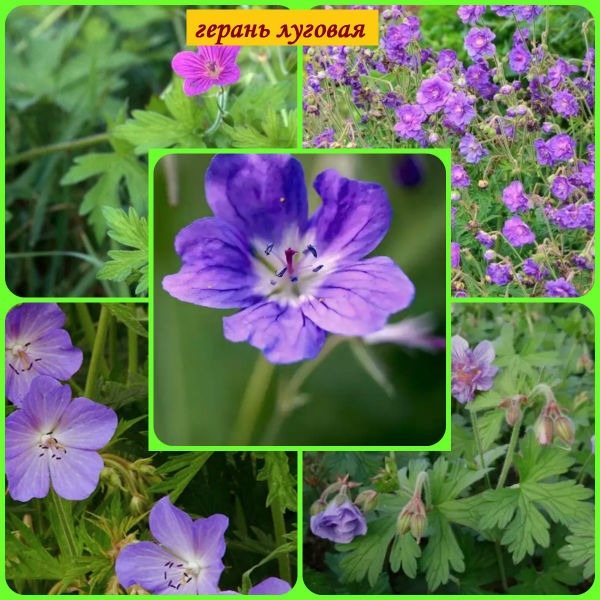

It is a light-loving species, so it is preferable to plant it in sunny, well-lit places. In the wild, it grows in the temperate climatic zone of Eurasia. It can be found in meadows, forest glades, forest edges, and forests.
Leaves on long petioles 10-20 cm long and 6 to 16 cm wide, three, five and seven separate. The flowers are large and numerous. The color can be lilac-red, lilac-blue, blue-blue, bluish-purple. The main flowering of meadow geranium occurs in mid-June and lasts about a month.
Meadow geranium is successfully used in folk medicine, it is used as a soothing, astringent, wound healing, antibacterial, anti-inflammatory agent.
It is an excellent melliferous plant and a "supplier" of flower pollen. In addition, green paint can be obtained from it.
Meadow geranium varieties
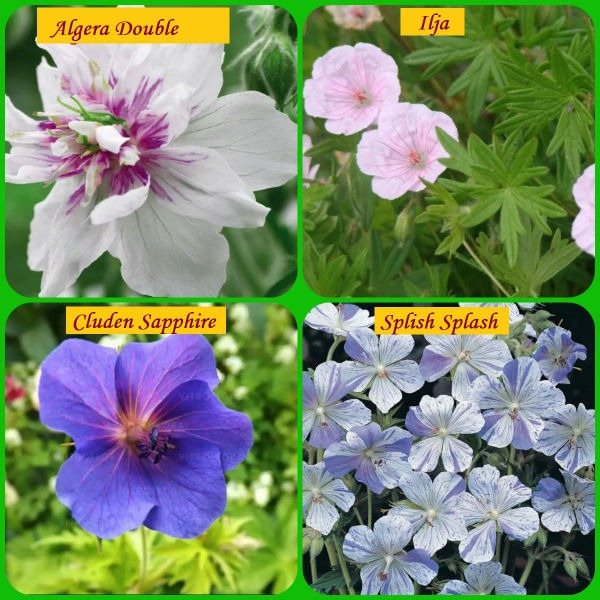

Algera double A compact bush, reaching sizes up to 50 cm and 30 cm in height and width. Quite large (4 cm in diameter) terry flower petals are a distinctive feature of this variety. The color is white with a lilac center.
Cluden sapphire The height of the bush is 0.55-0.60 meters, the width is 30-35 cm. The flowers are blue with pinkish veins. Flower size is about 4 cm.
Ilja Tall geranium (70 and 45 centimeters in height and width). The flowers are simple (five petals) of a light, delicate whitish-pink color.
Splish splash The bush grows up to 50 centimeters and can grow in breadth up to 35 centimeters. The white flowers are spectacularly adorned with small blue strokes and blotches.
Varieties of hybrid meadow geranium
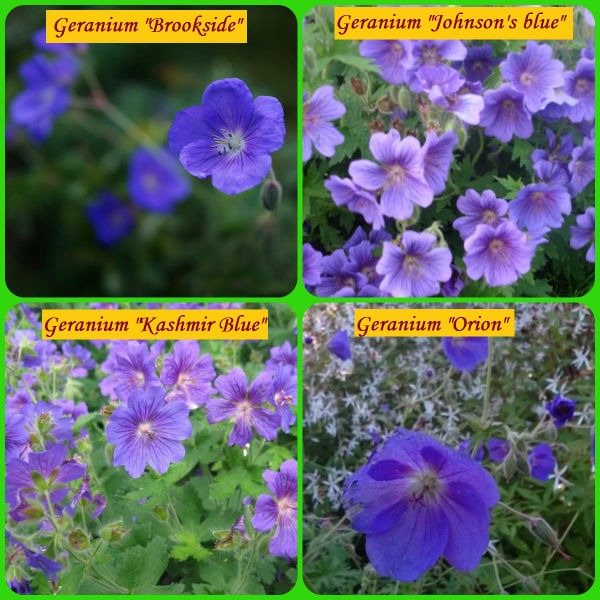

Jonson's Вluе The variety is obtained by crossing with Himalayan geraniums. The bush is up to 50 centimeters high and 30-35 centimeters wide. A distinctive feature of the hybrid is considered to be abundant, long flowering. The flowers are large (up to 40 mm), blue in color with darker veins and a small light central spot.
Brookside The variety was obtained by crossing the meadow geranium with the clarke geranium of purple color (Geranium clarkei "Kashmir Purple"). The bush of this hybrid is compact and uniform. It grows about 40 centimeters high and 45 centimeters wide. The flowers have a simple shape of five blue petals with dark blue veins and a white center.
Kashmir blue The variety was born by crossing the meadow geranium and the Clarke white geranium (Geranium clarkei "Kashmir White"). The bush has dimensions of 50 and 45 centimeters (height and width, respectively). The flower petals are blue with darker veins.
Orion A beautiful, compact bush of almost the same height and width (50 and 40 centimeters). The flowers are large enough (up to 50 millimeters), rich blue color with a light blue small center.
Small-grained geranium
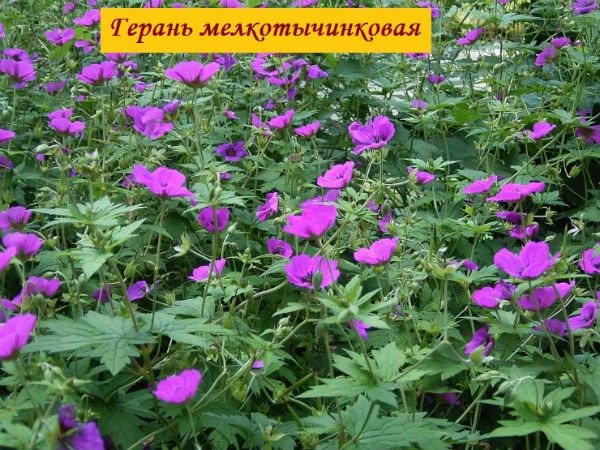

It is also known under one more name - Armenian geranium. The plant is perennial, the rhizome is thick and short. The height can reach 1.20 meters.
The homeland of the plant is the Southwestern Caucasus, North-East of Turkey. The leaves are long (15-20 cm), lobed. The color of the leaves changes with the season: in the summer - green, in the spring - crimson, in the fall - red. The flowers are medium-sized (40 mm in diameter), the color is bright, crimson, the center of the flower is black. It begins to bloom in the month of June.
Small-grained geranium and hybrids derived from the variety are good for decorating various landscape designs.
Varieties and hybrids of small-grained geranium
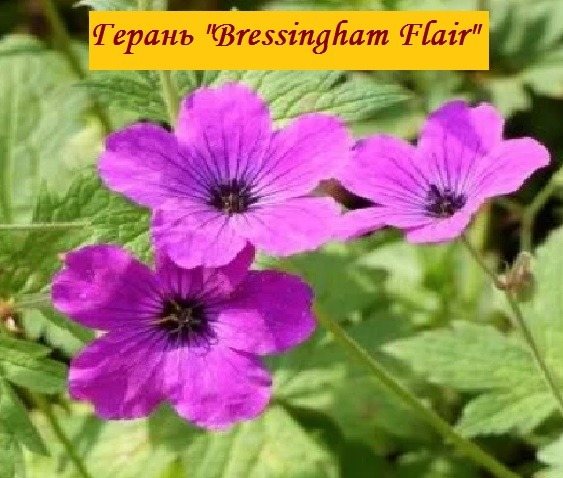

Bressingham flair Is the first officially registered geranium variety of this species. Has flowers of a pale purple-violet color.


Ann folkard A hybrid bred by crossing the small-grained geranium and Geranium procurrens. Plant height - up to 60 centimeters. The color of the flowers is pink - purple, the veins are of a darker color of the same tones. It begins to bloom in June. Duration of flowering - until September. The color of the leaves is yellow-green.
Description of the species
Meadow geranium is a herbaceous perennial with a small creeping rhizome and a well-developed ground part, reaching a height of 30–80 cm. The lower leaves of the bush are feathery, often incised, located on long petioles, the upper ones are short, sessile.


The stems are covered with fluffy hairs that exude a spicy aroma. The flowers are simple, predominantly lilac-blue, arranged in small umbellate inflorescences. In decorative species, flowers are double and multi-colored.
This geranium should not be confused with pelargonium, as there are significant differences between them.Pelargonium refers to indoor or decorative species. Meadow geranium, like forest or field geranium, is a wild plant that lives in its natural environment. Geranium bloom begins in late May or early June and lasts at least 2 months. It is an excellent honey plant and a remedy for many ailments.
Geranium flatfoot


Grows in the meadow part of the Caucasus. This perennial shrub has a thick rhizome and grows to 0.60 m in height. The bush forms a beautiful spherical shape up to 1 meter in diameter. In one place it can grow up to 15 years. The leaves are green in color with a bluish tint, flat-leafed (20 * 12 centimeters), slightly pubescent. The flowers are large purple-blue in color. Closer to the center, the color becomes lighter.
How and where to plant it?
Generally, gray geranium - unpretentious herb, perfect for planting in open ground. But there are a number of nuances that should be taken into account.
Lighting and location


The soil and the place for planting are selected depending on the herbaceous geranium variety. Sunny plots are intended for varieties such as Gray, Lugovaya, Himalayan, Magnificent. In addition, these species need abundant watering, in contrast to the Red-brown geranium, which loves a lot of sun and does not tolerate excessive moisture. But partial shade and constantly moistened soil will be appreciated by Swamp geranium. Georgian geranium will adorn any alpine hill.
It is better to plant herbaceous geraniums in islands, but due to the fact that the plant grows rapidly, the distance between the bushes should be at least 30 cm.
Soil requirements
Sand and peat must be compulsory components of the soil. During autumn or spring digging, it is recommended to add mineral fertilizers and humus to the soil, and just before planting the plant, the soil can be slightly "acidified" by adding a little citric or oxalic acid to it.
Boarding time
Planting of herbaceous geraniums is carried out in early autumn or spring.when the soil is already warmed up to + 15C - + 18C, it is not bad if 1 - 2 spring rains pass before planting.
Instructions
- Prepare the landing pit. Its depth should be such that the entire root system of the plant plus a couple of centimeters would fit freely into it.
- The bottom of the planting pit must be covered with a layer of drainage (crushed stone, broken brick, pebbles), and then - soil from a store or mixed with your own hands.
- The root system of the seedling is placed in the planting hole and carefully covered with earth.
- The soil should be lightly tamped for better fixation of the plant.
- After planting, the geranium must be watered abundantly.
- It is also necessary to mulch the ground around the young plant.
Mulching - the surface covering of the soil with mulch (dry peat, compost, bark) to protect it and improve its properties, for example, in order to prevent the soil from drying out.
Geranium Endressa
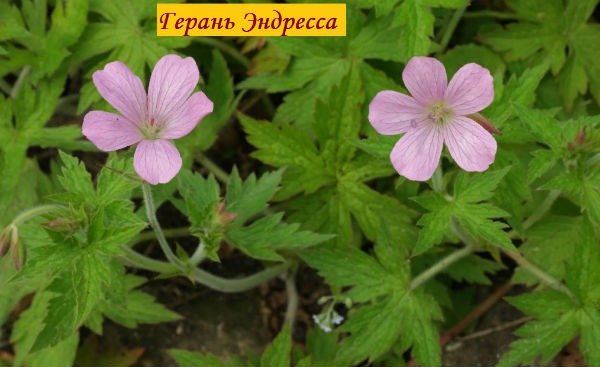

The main place of growth is the Pyrenees, therefore this species has another name - Pyrenean geranium. The plant has a long root system. The leaves are green, pubescent, reaching a length of 10-12 centimeters. Flowers of medium size (30-40 mm) have a bright pink color. Blooms from late May to August. Sprawling bush, can reach a height of 50 centimeters.
For her, the composition of the soil and illumination are not very important (it can grow in the shade, partial shade). The main requirement for the landing site is good soil drainage. Feels great under trees. Perfect for decorating rocky landscape structures.
Endressa geranium varieties


Beholder's Eye The height of the variety is 40-45 centimeters, the diameter of the bush is 60 centimeters. Flowers 25-30 millimeters in diameter, dark pink in color with a pearlescent tint, dark veins.
Wargrave Pink The bush is almost the same in height and width (up to 0.60 m). It is strewn with small-sized flowers of a pale pink color. The leaf plate is deep green, palmate.
Betty Catchpole Height - up to 50 centimeters, bush diameter up to 60 centimeters.Leaves are green in color, strongly dissected. The flowers are pink in color, smoothly passing from a lighter shade at the edges of the flower petal to a darker shade in the center.
Care rules
- Watering... Despite the loyal attitude of geraniums to drought, it is advisable to follow the watering of the plant, to prevent stagnation of water in the soil.
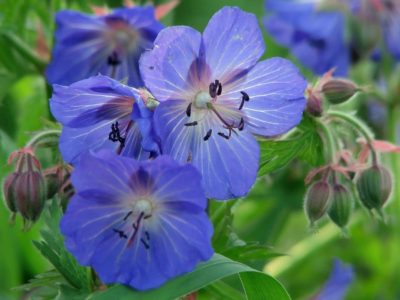

Fertilizer.Every spring it is necessary to fertilize the soil, enriching it with minerals that have a beneficial effect on the growth and flowering of the plant.- Weeding... For effective and fruitful development, you need to rid the flower of the neighborhood with weeds.
- Pruning... After flowering and wilting, the flowers will need to be removed, the same should be done with dry stems in order to allow new shoots to grow and please their owners with their appearance.
- Transfer... After 3-4 years, geraniums on the site will take up a fairly large place, in early spring it will be necessary to transplant the plant, dividing it into several parts.
Similar care is needed for room geraniums at home.
Himalayan geranium


Distributed in the alpine and subalpine meadows of the Himalayas, Afghanistan, Tibet, Tajikistan. A plant with a well-developed root system. Grows up to 60 cm.
The leaves have a lobed shape with unevenly dissected edges. Large flowers - up to 50 mm in diameter. There can be two flowers on one pedicel.
The color of the flowers is bluish-violet with streaks of red. It can bloom from late May to early autumn.
A feature can be called a low growth rate.
Plants are not demanding on the composition of the soil, the main thing is that the soil is loose and moisture in the soil does not stagnate (there is a good drainage system).
Varieties
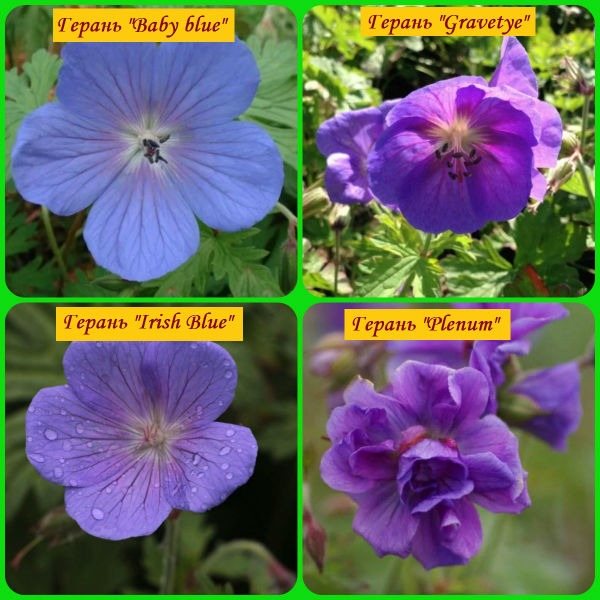

Baby blue A small compact bush 30 centimeters high and 35 centimeters wide. The flowers are large, blue-violet in color with little noticeable veins.
Gravetye The flowers are large in size (4.5-5 cm), blue-violet with reddish veins. Closer to center - approaches magenta. The center of the flower is white.
Irish blue A small compact plant of approximately the same height and width (up to 30 and 35, respectively). The flowers are large (up to 5 cm), the color is violet-blue, closer to the center it changes to light reddish shades. Ideal for edging flower beds, ridges, paths. It goes well with silvery pink and light yellow flowers.
Plenum One of the few varieties that has double flowers. Small bush - up to 30 cm in height, about the same in width. Geranium flowers have a double shape, the color is lilac-blue with a pink or purple tint. The pubescent leaves are dark green. The leaf plate is palmate in shape, unevenly dissected.
Landing features
Geranium is unpretentious in nature, drought-resistant... The geranium spot can be around the clock, moderate or low light.
It is worth choosing good soil drainage, then geraniums are easier to root.
As for watering, this plant does not like it when the roots are in excessively moist soil, so a sense of proportion will be the main thing in this matter.
It is worth planting geraniums in early spring after the end of frost... The soil must be loosened or plowed before planting.
Geranium Renard


The Renard geranium comes from the Alpine regions of the Caucasus. A perennial plant with a well-developed thick root system. This plant has unusual leaves.
They have long pubescent petioles, and the leaf plates are, as it were, covered with pimples. The color of the leaves is olive green.
Plant height no more than 25-30 cm.
The flowers are white with pronounced purple streaks. Flowering can last all summer. It grows and develops well on stony soils.
Photo of a field plant
This is what a wild geranium looks like in the photo.
Geranium robert
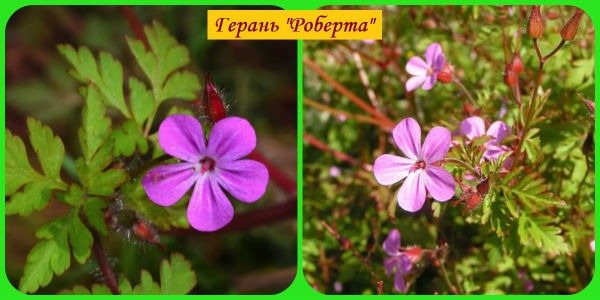

Distributed in deciduous and mixed forests of Europe, Asia, North America and Africa. Prefers shade or partial shade.
This species thrives in mountainous areas - it can grow at an altitude of 1500 meters above sea level.
The height of the plant is from 30 to 50 cm. The leaves are separate, strongly indented, outwardly a bit like fern leaves. In autumn they acquire a beautiful orange color. The stem is covered with harsh brick-colored hairs.
Due to the fact that it reproduces well by self-seeding, it can form dense thickets. The flowers are not large (up to 2 cm in diameter), the color is light pink.
It is successfully used in folk medicine as a wound healing, antimicrobial, hemostatic agent.
Popular varieties
- plant height;
- color of flowers;
- photophilousness;
- drought resistance.
High (from 50 cm) include:
- "Swamp" - up to 70 cm.
- "Patricia" - from 80 to 90 cm.
- "Lugovaya" - up to 1.2 m.
To low (up to 50 cm):
- "Balkan" - 30 cm high.
- "Large-flowered" or "Himalayan" - from 30 to 50 cm.
- "Rosanne" - up to 40 cm.
- "Magnificent" - 50 cm.
From a variety of geranium species, you can choose almost any color shade... For example:
- "Meadow" will bloom in a lilac-blue tone (you can learn more about meadow geranium here, and more details about the medicinal properties of meadow geranium can be found in this article).
- "Balkan" has purple or reddish flowers about 3 cm in diameter.
- "Czakor" is red.
- "Marsh" - with medium-sized purple flowers.
- "Magnificent" - will surprise you by the fact that at first the buds will be light purple, and by autumn they will acquire a brick shade.
- "Large-flowered" or "Himalayan" - large purple flowers with reddish veins in diameter up to five cm.
- "Georgian" - with purple buds.
- "Blood red" - with double, rose-like flowers.
- "Rosanne" - large bright blue inflorescences with white - although its flowering cannot be called plentiful, experienced gardeners recommend planting hosts together with "Patricia".
Reference. Hosts are rosette plants growing in the form of decorative greenery.
Photophilousness is characteristic of species:
- "Himalayan".
- "Magnificent" (more about the magnificent geranium, you can learn about its planting and care here).
- "Georgian".
- Renard.
- "Flat-petalled".
- "Large-rhizome".
- "Small grains".
Shade-loving species:
- "Forest" (more details about forest geranium can be found in this article).
- Roberta.
- "Red-brown".
Drought tolerant species:
- "Ash".
- "Dalmatian".
- "Large-rhizome".
More information about all varieties and types of garden geraniums can be found here.
Gray
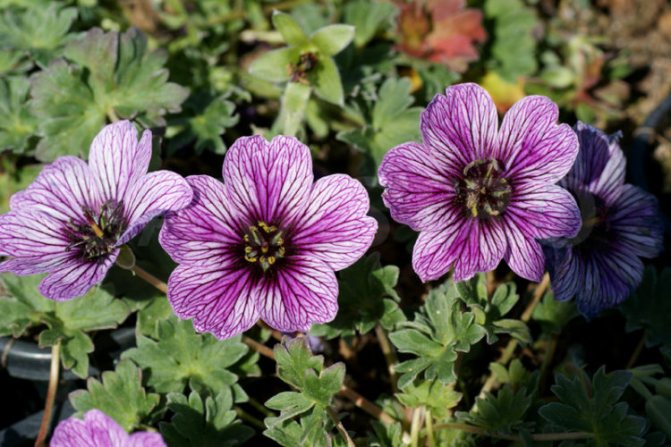

Geranium gray or otherwise - "Renard" (Geranium renardii) occurs naturally in the meadows of the Caucasus. it perennial plant with a thick rhizome and weakly branched stems, great for open ground.
This species is characterized by:
- compact bush up to 45 cm high and up to 50 cm wide;
- gray-green leaves with wavy edges;
- large white flowers with lilac and darker veins;
- bloom in June-July.
Geranium Wallich
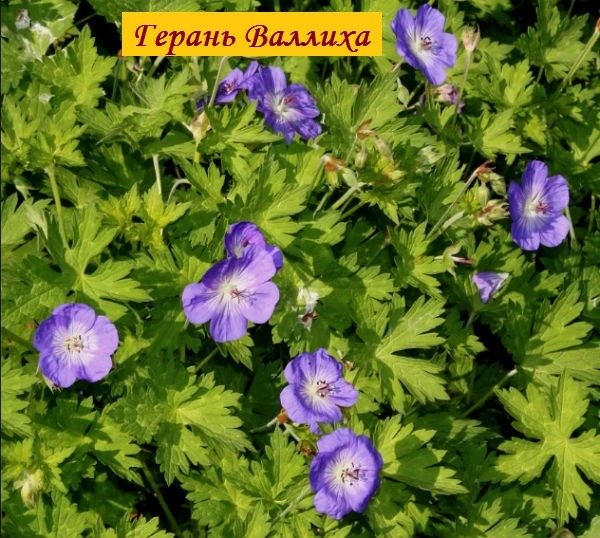

A perennial low plant (up to 30 cm in height), and in width it can reach one and a half meters. Thanks to these parameters, it is excellently used as a ground cover plant.
In the wild, it can be found in northeastern Afghanistan and on the territory of Kashmir, located on the Indian subcontinent.
The leaves are quite long - up to 15 centimeters. Flowers are rounded with a white center and color from lilac to dark purple. Flowering time is from mid-July to early October.
Wallich geranium varieties
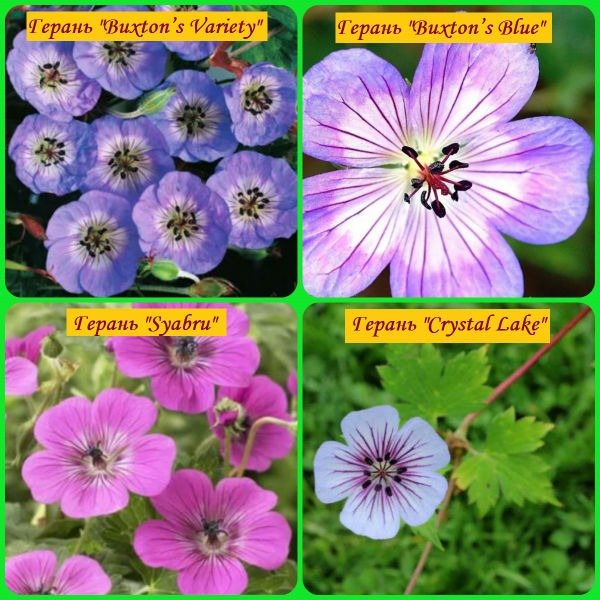

Buxton's Variety A low plant (no higher than 30 cm) with abundant foliage. The flowers are medium in size (up to 30 mm), with a large white center. The flowers are blue-violet. A feature of this variety can be called a long flowering period - up to the first frost.
Buxton's Blue The height of the plant is the same as that of most representatives of this species - up to 30 cm.The flowers are violet-blue, petals with dark purple veins with a pronounced light center and dark stamens, which look spectacular against the light background of the center of the flower.
Syabru Representatives of this variety have the same parameters as other Wallich varieties. The difference between the flowers of the Syabru variety is that they are bright pink with a small white center, clear dark veins.
Crystal lake This variety is notable for the pale blue (almost white) color of the flower, on the petals of which there are dark purple veins.
Use for diseases
The list of diseases for which meadow geranium is used:
- ulcers;
- purulent wounds;
- abscesses;
- rheumatic joint pain;
- genital and anal fistulas;
- stomatitis;
- pharyngitis;
- angina;
- alopecia;
- leucorrhoea;
- malignant neoplasms;
- bone fractures;
- epilepsy;
- fever;
- upper respiratory tract diseases;
- enteritis;
- gastritis with low acidity;
- food poisoning;
- dysentery;
- prolonged heavy menstruation;
- bleeding with hemorrhoids;
- uterine bleeding;
- inflammatory diseases of the female genital organs;
- urolithiasis disease;
- gout;
- rheumatism;
- heart diseases.
Geranium large-rhizome


Another name for this species is Balkan. This is due to the fact that the main distribution area of the Apennines, the Balkans, the Alps. Geranium grows up to 20-40 centimeters in height, has a shape close to a ball. The root system of this species, branched, is located close to the soil surface.
A versatile plant in the sense of a planting site - it can be planted in partial shade, in sunny places, grows well under trees. But, the most intense aroma comes from a geranium planted in a sunny place.
The leaves are large (up to 10 centimeters wide), bright green. The shape of the leaf plate is rounded, divided into several parts (from 5 to 7). In autumn, the foliage takes on a beautiful crimson-red color. Foliage can sometimes retain its green color during mild winters.
Flowers of pink shades, sometimes with admixtures of purple, bright, red shades.
Has a pleasant fruity aroma. Its oil has analgesic, wound healing properties, normalizes the work of the cardiovascular and nervous system. In addition, the roots and greens of the plant are successfully used in cooking, for example, as a flavoring for baking, in drinks, salads.
Varieties


Bevan's Variety A beautiful bush of almost spherical shape (height about 30 centimeters, width about 40 centimeters). The foliage is bright green. The flowers are medium-sized, only up to 25 mm in diameter. The color is purple with pink. On the petals, clearly expressed veins of a lighter shade are visible. The main flowering time is from late May to July.
Czakor It forms a beautiful, fairly compact bush, measuring 30 and 40 cm in height and width, respectively. Beautiful purple flowers of medium size (up to 4 cm in diameter). The foliage is moderately dissected, palmate. In the autumn, it acquires a beautiful yellow or dark purple color.
Lohfelden A bush of the Lohfelden variety reaches a height of 25-30 centimeters, and can grow up to 40 centimeters wide. The foliage is palmate, slightly serrated at the edges. The flowers are almost white with slightly pinkish veins. Bright pink anthers give a zest.
Ingwersen's Variety It can grow up to 40 cm in height and up to 60 cm in width. The preferred landing site is the sunny side and partial shade. Flowers of medium and large size - from 3 to 4 cm in diameter. The color is light pink. The main flowering time is mid June, July.


Insversen Perennial large-rhizome type of geranium, growing up to 30 cm in height. Insversen foliage is bright green, slightly pubescent. Flowers are medium in size, up to 30 mm in diameter, pink-purple. Purple anthers add showiness.
The preferred landing site is shade and partial shade. There are no special requirements for the soil, but drainage is required. Flowering time is June.
Spessart A compact bush about thirty centimeters high and forty centimeters wide. It is preferable to plant in sunlit places, but grows well in partial shade. Prefers slightly acidic, loose, well-drained soil. The foliage is green, wintering. The flowers are white with bright pink sepals, pedicels and anthers. Blooms in June, flowering duration up to 30 days.
Variegata A distinctive feature of this variety is its beautiful unusual leaves. They are two-colored - the main color of the leaf plate is green, and the edges are painted with creamy yellow spots of various shapes and stains. The flowers are pink-violet, purple.
It blooms well when planted in sunny places. When planted in a shady place, greens develop well, but the flowering is not so abundant. In one place it can grow up to 10 years.
Agrotechnical cultivation
She helps every gardener to properly care for their plantings in the backyard and get abundant flowering.
Reference.Agricultural engineering includes soil preparation, fertilization, selection of planting material, sowing or planting, and follow-up care.
Where and how to plant it? Rules and tips, instructions
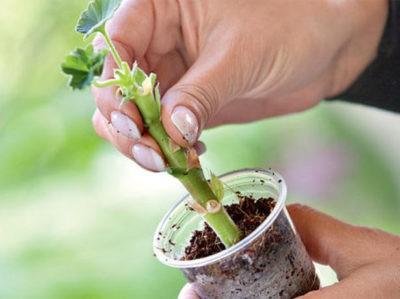

Before boarding, you must:
- determine the landing time;
- pick up a place on the site;
- choose planting material;
- prepare the soil.
Garden geraniums are planted in autumn or spring, when the ground warms up to 15-18 degrees Celsius. The landing site is selected in accordance with the characteristics of the type of planting material. For example, if gray geranium is photophilous, then it should grow in a sunny area. Since it has low bushes, it is planted along garden paths, curbs, in rocky gardens.
Garden perennial geraniums are planted in islands (when there are several bushes nearby) at a distance of up to 30 cm between the islets.
You can use as planting material:
- parts of the rhizome;
- seedlings;
- seeds.
After planting in the ground, the plant should be watered abundantly. Then mulch the ground around the seedling.
Important! Mulching (dusting with dry peat, compost, bark or wood chips) is done in order to avoid drying out the soil.
More details about planting and caring for garden geraniums in the open field can be found here.
Lighting and location
Gray geranium grows well on sunny slopes and near shrubs in partial shade.
Soil requirements
Soil preparation :
- loose soil is preferred;
- moderately moist and free of stagnant water;
- geranium loves slightly alkaline or neutral loams;
- when digging, rotted compost and peat are introduced;
- planting pits are made 15-20 cm deeper than the longest root;
- at the bottom - drainage (crushed stone, broken brick) from stagnant water is mandatory;
- pour a mixture of peat and sand on top of the drain.
How to take care of it properly?
Although geranium is considered an unpretentious plant, but minimal care is still required... It includes:
- watering;
- top dressing;
- pruning.
Watering
Watering geraniums is necessary systematic, but moderate. It is necessary to avoid both drying out and waterlogging, because its roots rot in stagnant water. It is better to water it not enough than to pour it over. Mulching will help the soil stay dry longer.
Watch the video on proper watering.
Top dressing
For geraniums, compost or peat introduced into the planting pit is enough, but for a more lush and long-lasting flowering, fertilizers with phosphorus can be used (even before flowering), and during the formation of inflorescences and during flowering, feed the geranium with potash fertilizers once every 2 weeks.
Pruning
Why is it necessary:
- to ensure the density of the bush and give it a more decorative look;
- to protect healthy shoots and leaves from gray rot (fungus "Botrytis cinerea Pers").
Geranium Cantabrian
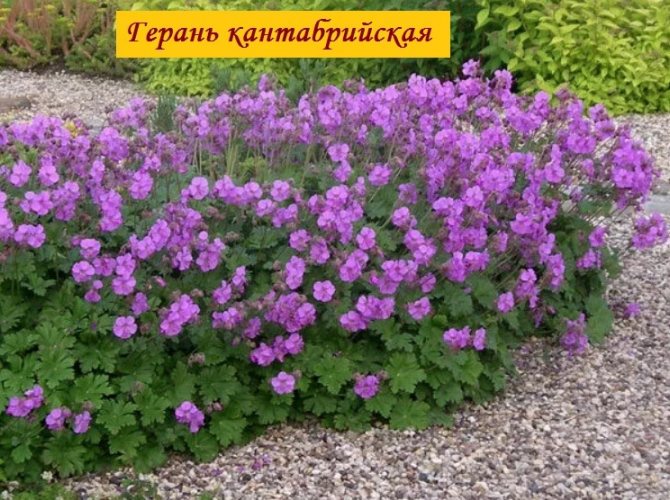

This is a hybrid bred by crossing large and Dalmatian geraniums. A perennial shrub that grows up to 35 cm in height and 55-60 cm in width.The leaves are green in color (retain their color in winter), have a lobed shape and a smooth glossy surface. The color of small in size (20-30 mm) flowers, depending on the variety, can be white, purple, pink.
Cantabrian geranium varieties
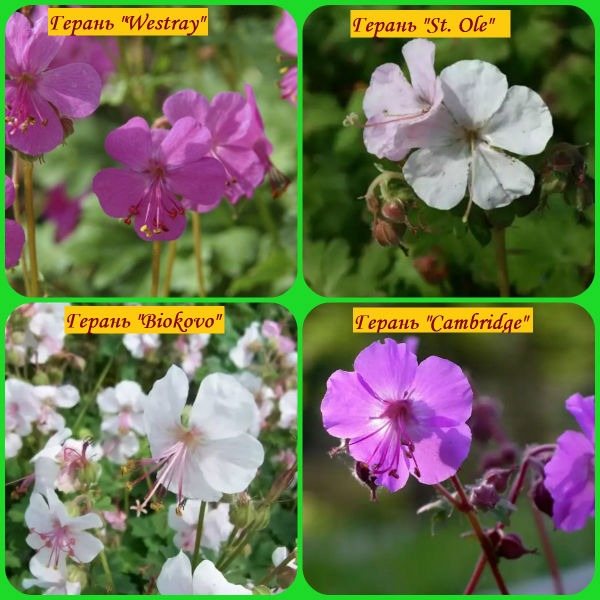

Westray A compact shrub with a beautiful and abundant flowering that lasts almost until the end of summer. The flowers are medium in size and intensely pink in color.
St. Ole The height of an adult plant is 25-30 centimeters. Flowers are slightly lilac with pink. Leaves are yellowish green. Feels great in a sunny place and in partial shade.
Biokovo With a standard height for the Cantabrian geranium (up to 30 centimeters), this variety grows up to 70-90 centimeters wide and can take up an entire flower bed. Flowers 25-30 mm in diameter, slightly pinkish petals. The center has a more intense pink tint. Filamentous filaments of the same shade as the center add a dramatic effect to the flower. Flowering time is from the second half of June to mid-July.
Cambridge Compact bushy plant with pink flowers. It grows well, blooms profusely in sunny places, but partial shade is not a hindrance to this variety.
In the next article about this amazing plant, I will talk about the features of growing, how to care for it at home.
Author of the publication
offline 2 years
Application and useful properties
Due to the rich set of useful components that make up the herb, medicines from meadow geranium are in demand by folk and traditional medicine in the treatment of a number of diseases. The tannins contained in greens have a strong antimicrobial and antibacterial effect. The extract made from the terrestrial part of wild pelargonium is capable of producing both invigorating and sedative effects on the human nervous system, depending on the volume of the drug taken.
In quackery and folk medicine, field geranium has long been used as a disinfectant, astringent, anti-inflammatory and healing agent in the treatment of various tumor formations, as well as for cracks and fractures of bones. Green, fresh, finely chopped leaves of the plant are applied to open wounds, boils, sores on the skin and venomous snake bites.
The herbal infusion will be useful for fever, nervous anxiety, insomnia, neurosis and epilepsy. Healing astringent geranium solution is prescribed for gastrointestinal disorders (diarrhea, enterocolitis, etc.) and bleeding. Lotions from a strong decoction or dusting from dried leaves are used for rheumatoid and gouty joint pains, wounds that do not heal for a long time and various inflammatory processes of the skin. Geranium root tincture is suitable for rinsing with stomatitis, periodontitis, gingivitis and sore throat (catarrhal and purulent).
Leaf infusion is taken orally for heart disease, arthritis, respiratory diseases, rheumatism, kidney stones. They rinse their hair with baldness. Finely chopped roots will relieve pain in case of tooth decay. A decoction of dried roots is drunk for dysentery and dyspepsia.
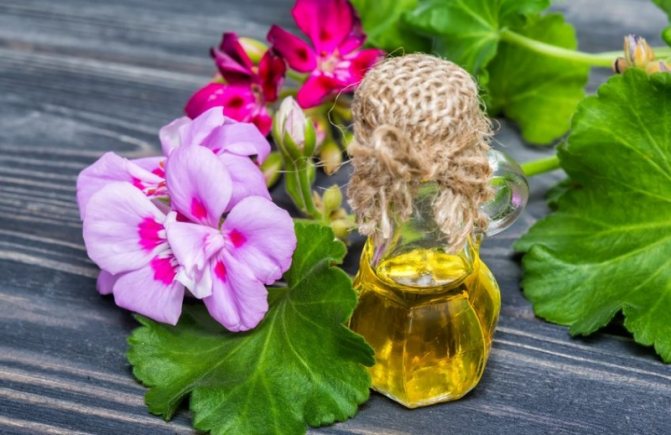

Blooming wild geranium is an excellent honey plant. Nectar accumulates in large quantities in the depressions at the base of the petals. Bees collect abundant pollen from numerous large flowers. The presence of this crop in the garden attracts insects to other plants in need of pollination, which has a positive effect on their productivity. The aerial part of the crane, together with alum, is used to dye fabrics green.
Contraindications
When using geranium, it is necessary to take into account not only its medicinal properties, but also contraindications. Preparations based on this herb are not recommended for use in the following situations:
- with intestinal atony;
- with an increase in acidity (gastritis, ulcer);
- syndrome of increased blood density;
- during the period of gestation and breastfeeding;
- young children.
Plant features
For the first time, geraniums settled in the garden in the days of ancient Greece. Gardeners noticed its resemblance to a bird's beak and nicknamed "geranion", which means crane. There is a legend that cultures with openwork leaf plates were cultivated in the gardens of Dioscorides. It was from there that the plant moved to European countries. Since the Middle Ages, people have noticed the healing properties of the culture and began to use it in medicine.
In Russia, an amazing plant appeared several centuries ago. Today, perennial garden geranium has more than 600 species.
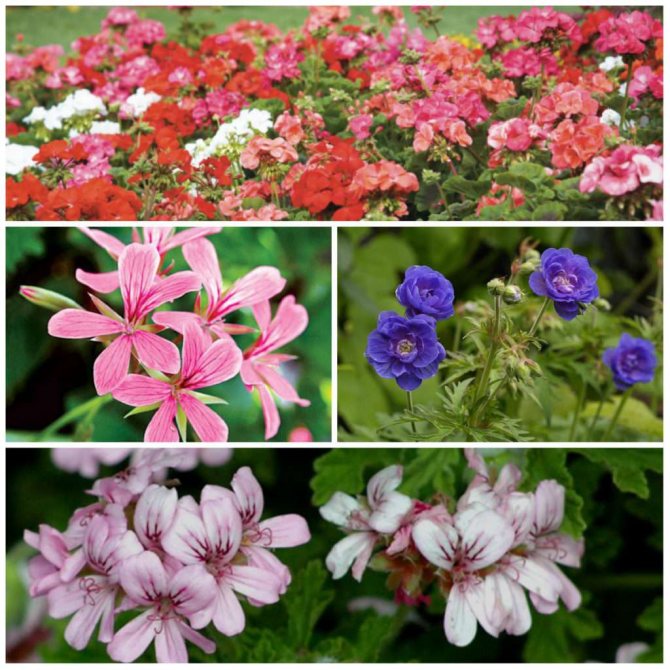

In nature, geranium grows on the open edges of leafy and coniferous forests. It can often be found on the banks of rivers and mountain glades. Perennial garden pelargonium retained most of the characteristics of a wild-growing flower and acquired its own characteristics:
- Adaptable to adverse weather conditions, hot summers and harsh winters.
- Refinement and sophisticated decorativeness.
- The flowers are colored in brighter colors, and some varieties bloom 2 times during the growing season.
- The foliage has become more variegated, and the flowers are large and double.
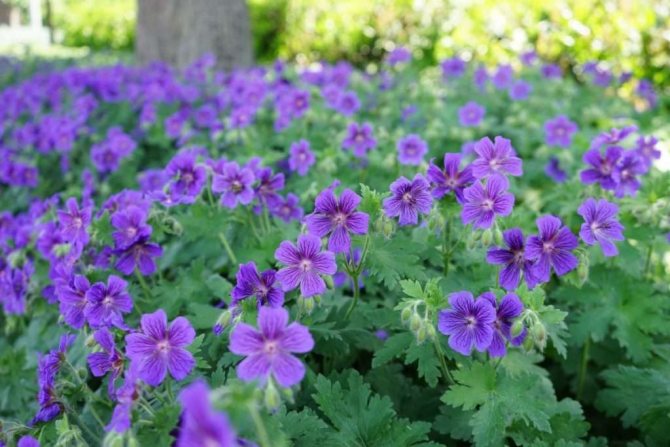

Varieties of garden geraniums differ among themselves in size and color shades. There are varieties with a color that does not exist in nature. As a rule, pelargonium flowers have 5 petals with characteristic veins that adorn the inflorescences. The leaf plates have also changed. They are able to decorate the garden even during the period of wilting of flower stalks. The leaves have different colors, variegated tones. Shape - from rounded to dissected.
Seed planting
It propagates not only by rhizomes, but also by seeds of garden geranium. Seed planting takes a little longer. It is characteristic that with such reproduction the varietal qualities disappear, a completely different variety of this type of garden culture is obtained.
It is better to take fresh seeds for sowing. But collecting them is not easy. You need to be patient. The seeds are in capsules, the valves of which burst when ripe, and the seeds scatter in all directions. The pod with unripe seeds is green. And when they are ripe, it turns brown.
But the shades of seed color are different and depend on the variety. You can put a paper bag on the pod, which will serve as a guarantee that the seeds will not scatter when fully ripe, and you will collect them. Of course, there is a lot of trouble, but it's worth it, because the seedlings will bloom next year.
It happens that garden geranium gives abundant self-seeding. Planting and grooming takes extra effort if you don't want the plant to multiply out of control. To do this, you need to cut off unripe seed pods and all faded flowers.
Plant pests and diseases
Garden geranium is not affected by pests, as they are deterred by its specific aroma. Therefore, she herself protects herself and the flowers around her from various diseases and infections.
But if, nevertheless, a disease is found, then this bush is cut off at the root and after a while new healthy greens grow. Those parts of the plant that have been cut off must be burned outside the site so as not to infect the land. All diseases can affect her only during cold, prolonged rains.
Pests appearing on garden geraniums:
- Aphids - to get rid of it, you need to spray the bushes with special preparations.
- Whitefly - they get rid of this misfortune with the Iskra drug.
- Goose - they can be collected by hand, since the treated leaves are harmful to them only for a week, and then the pesticides disappear, and the goose eats the leaves again.
Also, with low watering, yellowing of the leaf plates begins. If the lower leaves are actively crumbling, exposing the lower branches, then this indicates that she does not have enough sunlight.
These perennial plants are indispensable in landscape design - they hardly get sick and do not require special labor-intensive care costs.Small flowers are planted along the paths and on alpine hills, the tall one is planted around perennials, which gives the overall appearance the charm of the Garden of Eden.
Community of green men
Geranium, Geranium. Annual and perennial rhizome, herbaceous plants. Stems 40-60 cm tall, forked-branched. The leaves are palmate-lobed or finger-dissected. Flowers are single or two, axillary, sometimes collected in inflorescences. Flowering time - depending on the species - late May – August. Geraniums are widely distributed in botanical gardens in Europe, Asia, America and are offered by all flower nurseries.
Etymology
Derived from the Greek word geranos - "crane": in the shape of a fruit that resembles the beak of a crane. Already Dioscorides used this name for individual members of the family. In Germany, geraniums are called Storchschnabel, which means "stork nose", in England and the USA - Cranesbill, "crane". In Bulgaria, geraniums are called "health resorts" for the medicinal properties of most species. And only in Russia the Greek word is used - geranium.
Types and varieties of geranium
A large genus, about 300 species of plants are known, distributed mainly in the Northern Hemisphere, in regions with a temperate climate and in the mountainous regions of the subtropical zone.
In decorative floriculture, many species are used, as well as various garden forms and varieties. Large, with beautiful leaves and bright flowers, plants of the subalpine meadows of the Pyrenees, the Apennines, the Balkans, the Carpathians and the Caucasus have been introduced into the culture.
For convenience, geraniums are often divided into two groups: high (above 50 cm) and low (10-50 cm).
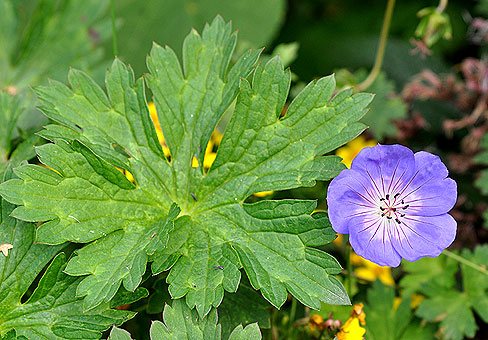

Geranium variety 'Johnsons Blue' - 50 cm high with bright blue flowers with a white core. Blooms in June-August.
1 group. Tall geraniums
Marsh geranium (Geranium palustre), Georgian geranium (Geranium ibericum), red-brown geranium (Geranium phaeum), blood-red geranium (Geranium sanguineum), forest geranium (Geranium sylvaticum), meadow geranium (Geranium pratense), geranium psilostemon), flat geranium (Geranium platypetalum).
Group 2. Stunted geraniums
Himalayan geranium (Geranium hymalayense), Dalmatian geranium (Geranium dalmaticum), large-root geranium (Geranium macrorrhizum), ash geranium (Geranium cinereum), Pyrenean geranium (Geranium pyrenaicum), Endris geranium (Geranium endressii)
Marsh geranium (Geranium palustre)
A common plant in waterlogged and floodplain meadows in Russia. In June-July, its purple flowers glow among the forbs of these meadows, giving them brightness.
Marsh geranium is a rhizomatous plant with large basal seven-partite leaves on long (up to 20 cm) hairy petioles; the leaves die off by August. Above them rises a flowering stem (50-70 cm), straight, thickened at the nodes, many times branched. On the stem are beautiful, five-part leaves, and at its top there are large flowers, two on the peduncle. The flowers are 2.5–3 cm in diameter, with ovoid petals, mostly wedge-shaped. In August, numerous seeds ripen, crumbling, they provide abundant self-seeding in suitable conditions.
Geranium magnificent or lush geranium (Geranium magnificum)
The species was obtained in culture by crossing Georgian geranium with flat-leafed geranium. The plant is 40-70 cm high. The leaves are round, five-part, toothed along the edge. The flowers are purple-violet, 4-5 cm in diameter. Prefers sunny or semi-shady areas with fertile soils, drought-resistant.
Spotted geranium (Geranium maculatum)
Rhizome perennial 35 to 60 cm high. Leaves are rounded, finger-dissected into 7 lobes. There are varieties with brown and bronze leaves. Flowers are white, pink, lilac-pink-pink, sometimes with a white center, 3 cm in diameter. Prefers partial shade, but with regular watering it can grow in sunny places. Needs loose fertile soil.
Popular varieties of spotted geranium:
‘Album’ - white flowers;
'Beth Chatto' - flowers are light pink, large;
‘Elizabeth Ann’ - pink flowers, chocolate brown leaves;
‘Espresso’ - flowers are pale lilac-pink, leaves are chocolate-brown.
Geranium Andris looks great in rockeries, where its graceful flowers are especially good against the background of stones. It is also suitable for container gardening.
Geranium Endressii
Homeland - the rocks of the Western Pyrenees.appeared in culture during the time of Napoleon. It grows in spreading clumps 20-30 cm high. Rhizome 25-50 cm long is located close to the surface of the earth. Leaves on long petioles are light green, pubescent, wide (up to 10 cm), five-membered. The flowers are light pink with darker veins, with a pearl tint, rather small, 3-3.5 cm in diameter. Blooms continuously from June to August. It grows quickly. Prefers a sunny location or partial shade, moderately fertile, calcareous, well-drained, stony or sandy soils, does not tolerate excessive moisture. Drought tolerant.
Popular varieties of Endris geranium:
‘Beholder’s Eye’ - flowers are fuchsin pink with darker - flowers are fuchsin pink with elongated petals and lighter veins.
Forest geranium (Geranium sylvaticum)
Perennial plant with a height of 40 to 130 cm. Leaves are rounded, seven-partite, with ovoid lobes, large-toothed. The flowers are numerous, in a loose inflorescence, two flowers per peduncle, wide open, lilac-purple or violet. Blooms from late May for about 20 days. Prefers shady places and fertile moist soils.


Forest geranium
Popular varieties of forest geranium:
'Nikita' - flowers are pink-lilac with a white spot; - flowers are pale pink-lilac, with darkish veins;
'Prelude' - flowers are pale pink with dark streaks along the veins.
Meadow geranium (Geranium pratense)
Plant of meadows, clearings, forest edges, light forests of Europe, Central Asia. A perennial plant with a short rhizome. Stems are not numerous, 50-120 cm high, covered with hairs. Numerous basal leaves, on petioles, vegetate from April to August. Leaves are rounded, semi-divided, slightly pubescent. The flowers are large, wide open, lilac-blue. Rounded petals. Blooms from mid-June for 30 days. Prefers sunny areas with fertile soils, needs regular abundant watering.
Popular varieties of meadow geranium:
‘Bittersweet’ - flowers are pale pink, with darker veins;
‘Cluden Sapphire’ - flowers are dark lilac, purple-lilac towards the center, with pink veins;
‘Mrs Kendall Clark’ - dark lilac flowers with light veins;
‘Elizabeth Yeo’ - magenta-pink flowers, very large with elongated petals;
‘Splish Splash’ - variegated flowers.
Geranium red-brown (Geranium phaeum)
Rhizome perennial 50-80 (up to 11O) cm high. Leaves are rounded, finger-dissected, light green with a bluish tinge. In the middle of summer, a brownish pattern appears on the leaves in the form of a blurred ring. The flowers are purple-brown with rounded, wavy petals along the edge, up to 2 cm in diameter. Blooms from May 40-45 days. Grows well in partial shade and shade, prefers fertile soils, uniform moisture, does not easily endure adverse conditions.
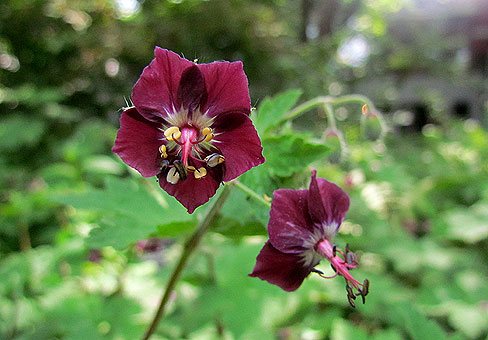

Geranium red-brown
Popular varieties of red-brown geranium:
‘Chocolate Chip’ - dark chocolate flowers with yellow anthers;
'Calligraphef' - flowers are pale pink, with a lilac border.
Ash geranium or gray geranium or gray geranium (Geranium cinereum)
Forms a compact bush 10-15 cm high. The leaves are round, 5-7-lobed, with a bluish tinge. The flowers are white, pink, purple, often with a dark spot in the throat or with a darker pattern along the veins, 3-4 cm in diameter. Blooms profusely in July – August.
An excellent plant for rockeries. Needs a sunny location, moderately fertile well-drained and lime-rich soil, protection from winter moisture.


Ash geranium
Popular varieties of ash geranium:
'Ballerina' - flowers are pale pink, with dark purple veins and - flowers are magenta-pink, with dark - flowers are pale pink with pink strokes.
Blood-red geranium (Geranium sanguineum)
Forms a dense hemispherical bush about 60cm high. Overwintering leaves, rounded, deeply dissected into linear lobes, acquire a bright color in autumn. The flowers are lilac-pink, 3-4 cm in diameter.Blooms from mid-June to August. Prefers a sunny location, moderately fertile calcareous soils, but thrives on all garden soils.
Popular varieties of blood red geraniums:
'Album' - pure white flowers;
‘Ankum’s Pride’ - purple-pink flowers, very bright;
‘Glenluce’ - lilac-pink flowers with dark streaks;
'Nana' - low to 15 cm cultivar with bright pink flowers,
‘Prostratum’ - low (10-15 cm) bush with dark pink flowers, characterized by long flowering;
‘Striatum’ (or ‘Lancastriense’) is a low (10 cm) bush, grows well, blooms from early June to mid-August, flowers are light pink with a dark eye.
Geranium large-rhizome or Balkan geranium (Geranium macrorrhizum)
A perennial plant with a branching rhizome, forms a dense closed thicket with a height of 30-45 cm. The leaves are rounded, divided into 5-7 lobes, slightly pubescent, when rubbed, they emit a characteristic smell of geranium. In autumn they acquire a beautiful reddish tint. The flowers are purple-pink, 2.5 cm in diameter, collected in few-flowered umbellate inflorescences. Blooms from June 20-30 days. It grows quickly, develops well on any garden soils that are not subject to stagnant moisture, in the sun, in partial shade and even in the shade.
Popular varieties of geranium large-rhizome:
‘Spessart’ - white flowers with pink veins;
‘Snow Sprite’ - pure white flowers;
‘Ingwersen’s variety’ - flowers are light pink;
‘Ynsversen’ - with purple-pink flowers;
‘Spessart’ - characterized by the presence of wintering leaves and charming white and pink flowers;
‘Variegata’ - with striped leaves, creamy yellow stripes.
Himalayan geranium or large-flowered geranium (Geranium himalayense, grandiflorum)
Plant of subalpine meadows of the Himalayas. It has been widely used in culture since the end of the 19th century. Like all geraniums, it is a rhizome plant with a rosette of pubescent leaves. Leaves are round, up to 10 cm in diameter, five-membered with unevenly dissected lobes. The flowers are large (4-5 cm in diameter), arranged in two on the peduncle, the original bluish-purple color with reddish veins. Three dark veins are visible on the calyx. Himalayan geranium blooms in late May and blooms all summer. Particularly interesting is the more compact form, the branched stems of which rise 20-30 cm above the ground. Most often in Europe, a low-growing (up to 30 cm) variety with blue flowers is grown - Fohnson's Blue, characterized by long, abundant flowering.
Georgian geranium (Geranium ibericum)
It grows in the subalpine and alpine meadows of the Caucasus and is one of the most beautiful geraniums. From the collections of regional botanical gardens, she long ago began a victorious march through the flower gardens of Russia, because differs not only in beauty, but also in longevity, resistance to diseases, not exacting culture.
Georgian geranium is a perennial plant (without dividing and replanting it can grow in one place for up to 10-12 years), forming a powerful bush 60-80 cm high. The rhizome is short, thick, oblique, located in the soil at a depth of 5-15 cm. In the spring ( in early May), rounded basal leaves appear on long pubescent petioles (up to 20 cm). In outline, the leaves are pentagonal, rounded by 2/2 dissected, rhombic, with jagged edges. The color of the leaves is greenish-bluish from pubescence, in the fall they turn red and die off when frosts come in October-November. Flowers up to 4.5 cm in diameter, purple with purple veins, collected in an umbrella-shaped inflorescence. The petals are wedge-shaped, notched. Flowering in Central Russia begins in mid-June and lasts about 40 days. Abundant flowering. The rhizome contains black dyes.
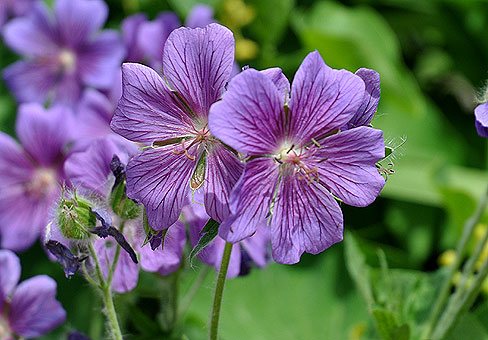

Geranium geranium
Dalmatian geranium (Geranium dalmaticum)
The most exquisite geranium from the limestone cliffs of the Balkans. Thanks to creeping thin rhizomes, it forms a low (10-15 cm in height) loose ground cover of rounded gracefully dissected leaves on thin petioles. At the end of June, the cover is colored with pale pink flowers (their diameter is 2.5-3 cm). geranium blooms for a long time, until January. The seeds ripen in August-September. After the first frost, the leaves take on a beautiful pinkish-red color and then die off.In addition to the species, there are also varieties of Dalmatian geranium in culture, especially a variety with white flowers is grown: Dalmatian geranium ‘Album’.
Geranium cantabrigense
Long-rhizome evergreen perennial, forms a thicket 20-25 cm high. Rhizome is horizontal, highly branched, rapidly growing. Blooms in June, profusely, pink flowers, 2.5-3 cm in diameter; seeds in July. Vegetative reproduction. The popular 'Cambridge' variety.
Geranium platypetalum
Homeland - mountain meadows of the Caucasus.
Short-rhizome perennial 60–70 cm high. Rhizome is thick, short, round bush. The plant grows from mid-April to November. Seed and vegetative reproduction. The whole plant is fragrant, densely covered with hairs. leaves are gray-green, rounded, up to 12 cm wide, on long petioles, incised 2/3 of the length into wide, ovoid lobes. the leaf blade is thin, soft from pubescence. Leaves appear at the end of April and die off with the onset of frost. Stems are straight, they bloom blue-violet flowers with a diameter of 4-5 cm, with wide, wedge-shaped, hairy-pubescent petals at the base, notched along the edge. Flowering begins in June and lasts about 2 months; seeds ripen in August.
Small-grained geranium (Geranium psilostemon)
Mountain meadows of the Caucasus. Short-rhizome perennial 70–100 cm high. Rhizome. thick, short. The plant grows from mid-April to November. Blooms in June, seeds in July. Seed and vegetative reproduction.
Geranium renardi
Dry slopes of the Caucasus. Short-rhizome perennial 20–25 cm high. Rhizome. thick, oblique. The plant grows from mid-April to November. Blooms in June, seeds in July. Seed and vegetative reproduction.
Geranium care
All geraniums mainly prefer sunny areas, some species tolerate shade and partial shade, these are red-brown geraniums, blood-red geraniums and forest geraniums. They develop better with moderate uniform moisture, they need fertile soils. Dalmatian geranium, large-rhizome geranium and ash geranium need lime-rich soils, and Renard's geranium and Andris geranium grow well on sands and pebbles. Geraniums are stable in culture. They are not damaged by diseases and pests. Most species and varieties are unpretentious and winter-hardy. Geraniums do not need frequent transplants; they can grow in one place for 7-10 years.
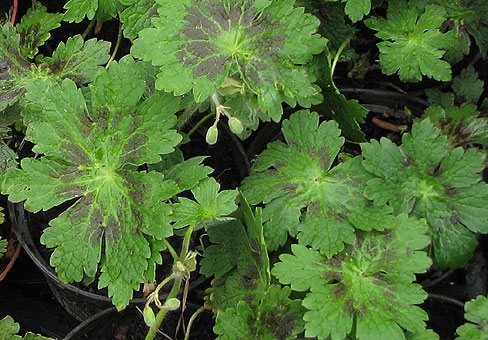

Geranium garden variety Samobor
Geranium propagation
Propagated by sowing in August, immediately after collecting seeds, or before winter - in open ground. Garden forms and varieties are propagated only by dividing the rhizomes in early spring or late summer.
How to take care of it properly?


Watering... Watering must meet the needs of a particular plant species, which were discussed above. Most often, it should be regular and moderate, especially if the soil around the seedling is mulched.- Top dressing... The first fertilization is done immediately after planting. In spring, preference should be given to nitrogen fertilizers, which contribute to the growth of deciduous and root mass. Starting in June, a complex fertilizer with phosphorus and potassium is usually applied every 2 weeks for lush and long flowering.
- Pruning... It is imperative to monitor the ornamental type of the plant and systematically remove wilted inflorescences and withered foliage. Do not forget and should also be about cleaning the soil around the plant from weeds.
Read also In which forests does juniper grow
Garden geranium: description
Garden geranium should not be confused with pelargonium. Geraniums are perennial plants. And pelargoniums belong to the genus of annual crops. These are both plants from the Geraniev family, but belong to different genera. Geranium has become a well-known horticultural crop due to its ability to grow in open ground, so it began to be grown in gardens, in flower beds.
Garden geranium does not need pruning.When the flower has faded, there is no need to remove the inflorescences. They find their own place under the foliage. They hide so cleverly that the decorative effect of the plant is not disturbed.
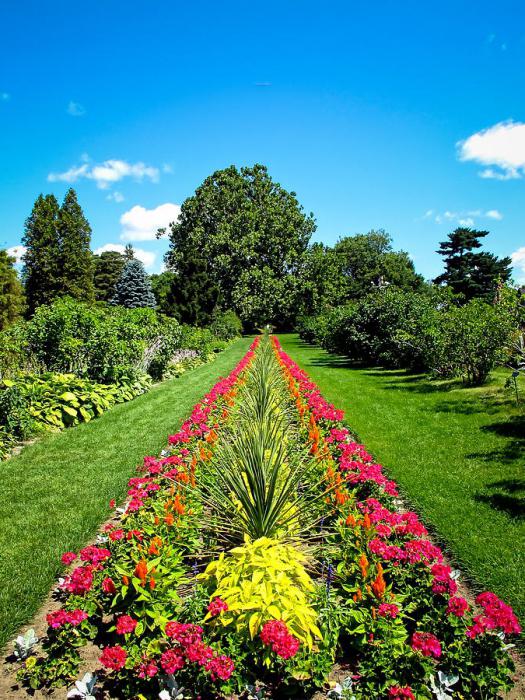

Garden geranium can grow in a flowerbed with other flowers. Care and cultivation will have to be diversified. Geranium must be weeded until dense foliage appears and the soil loosened. Until the twigs are intertwined and form a solid carpet, apply mineral and organic fertilizers. On top of the fertilizers, you need to put a small layer, about five centimeters, of mulch. Throughout the summer, the plant needs watering. Geranium is a plant that is resistant to dryness. But this does not mean that it does not need to be watered at all.
This garden culture is not susceptible to various diseases and damage by pests, as it has a specific aroma with a content of phytoncides. It repels insects and infections. Thus, garden geranium protects not only itself from diseases and insects, but also growing plants in the neighborhood.
Growing conditions
Geranium Himalayan plant is not demanding. But for successful growth and development, it still requires certain conditions.
Lighting
Like other geranium species, this species prefers open, sunny places. But she can also put up with light partial shade, where her flowers become especially large.
The soil
Well-drained fertile soils are suitable for growing this type of geranium. Like most rhizome perennials, it does not tolerate stagnant soil moisture, especially in the spring.
Reproduction methods
There are several ways to propagate perennial geraniums.
Seeds
This is the most time consuming and not always reliable method. When sowing seeds, there is no guarantee of preservation of the species characteristics of the variety. There are hybrid geranium species that do not produce seeds at all. Some reproduce by self-seeding. To prevent this from happening, you need to control the process of seed ripening and collect them on time. When geraniums are propagated from flowering seeds, it is worth waiting only for the next year.
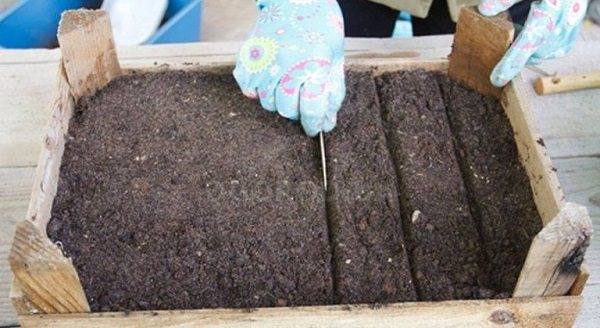

Cuttings
Cut off young shoots from adult bushes, on which there are several leaves. Place the cuttings in water and keep in a warm place until roots appear. Petioles with roots are planted in a prepared place. You can immediately plant them in the ground for rooting. Cover with a jar on top, creating greenhouse conditions. Remove the shelter when new shoots appear.
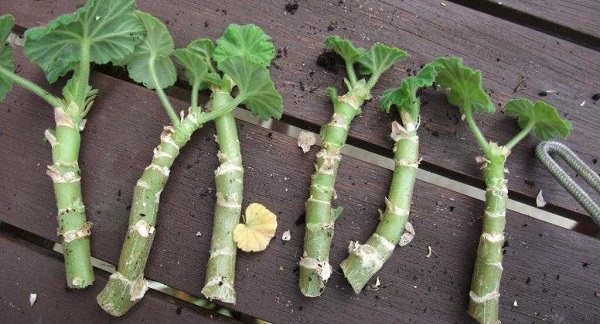

By dividing the bush
The easiest and most common breeding method. It is recommended to divide the bush during transplantation of a plant that has grown greatly. The division can be done in late autumn or spring. Geranium tolerates the procedure more easily in the fall, when the dormant period begins.
Prepare the pits in advance. They should be deeper than the root system of the divisions. Dig up a bush for separation, shake off the ground. Divide the rhizome into parts with a sharp tool so that each has at least one renewal bud. Pour drainage into the pits, a mixture of peat and sand on it. Plant the plants at a distance of at least 25-30 cm from each other. Compact and water the soil.
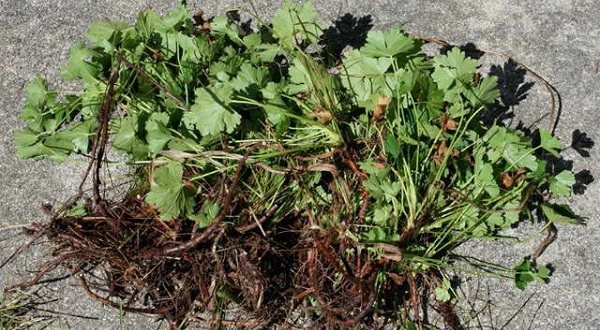

Autumn care, collection of seeds and wintering of the plant
If it is planned to propagate geraniums in the future by seeds, they must be collected in time. First you need to determine from which flowers they will collect and put gauze bags on them. This will help to avoid self-seeding and preserve the planting material. Seeds quickly lose their germination, so they cannot be stored for a long time, they need to be planted as early as possible.
In autumn, when persistent cold weather sets in, it is recommended to protect the bushes from freezing. A month before the dormant period, you need to stop all feeding. After flowering, remove all dry inflorescences, cut off the stems by 1/3. There are types of geraniums that do not require pruning for the winter.
If the winters are not very frosty and snowy, then the plant can be left without shelter. But to reduce the risk of freezing, it is better to cover the base of the bush until spring with straw, dry leaves or coniferous spruce branches.When it snows, cover the bush from above.
Garden geranium - beauty and legends
One can argue endlessly about the beauty of flowers. But not every flower is honored to be an object for versification. The authors of the poems are our contemporaries and poets of past centuries. Geranium is a symbol of home, warmth and comfort. They also call her grandmother's flower. Now this is not the personification of something outdated, but a symbol of the family, home and familiar.
For many peoples of the world, geranium is a symbol of vigor, strength and health. Her flowers, according to popular belief, are an excellent love spell. Always carry them with you, and your beloved will pay attention to you. In India, white geranium grows at the entrance to any house. In this way, people protect themselves from snakes entering the dwelling, which avoid any contact with the white geranium during its flowering. Even leaflets are useful. If you put them in jam, you can avoid the appearance of mold.
Characteristics of garden geranium
Garden geranium is a beautiful lush compact bush, is a herbaceous perennial. The height of the plant is varied: there are both undersized and tall species.
Leaves are dense, carved lacy. There are various sizes and shapes - they have rounded or pointed edges.
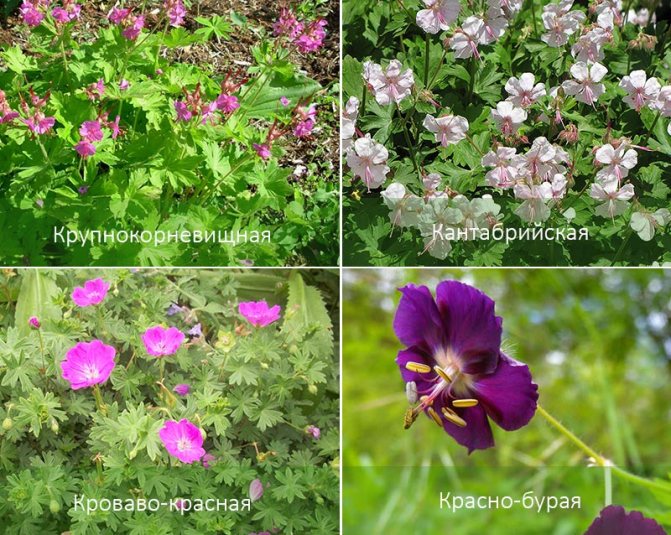

The buds of the plant are up to 5 cm in diameter and consist of about 5 petals. The color of geranium flowers has a wide color palette. All shades of red, white, pink, and purple are found. Plants of the geranium family have a pleasant sweet aroma.
The most important advantage of this species is its health: the flower is immune to drought, unpretentious in care and has excellent immunity.
Use in landscape design
The unpretentiousness of this perennial opens up wide opportunities for its use in landscape compositions. From large-flowered geranium, you can create both separate flower compositions, and introduce it into flower beds with other perennials, plant near water bodies.
Abundantly blooming clumps of geraniums against the background of an emerald green lawn look no less effective. With great success, this perennial can be used to decorate flower borders or flower beds.
Himalayan geranium is a ground cover plant, so it can be used to create various rocky slides and rock gardens. This plant is able to decorate with itself various inclined surfaces and slopes. A strong and branched root system of geraniums will help to strengthen them.
While watching the video, you will learn about growing geraniums.
Growing Himalayan geraniums on your site is not at all difficult. This task is even within the power of a novice florist. The most important thing is to carefully study all the requirements of the culture and create the most suitable conditions for its cultivation.
Attention super FLY!
The homeland of geraniums is South Africa. At the beginning of the 16th century, scientists and sailors brought it to Europe by ships. At first she decorated the gardens of the nobles. In Russia, the flower appeared in the 18th century. Domesticated began to be called pelargonium. Consider the rules for planting and caring for perennial garden geraniums.
Temperature and lighting
Geranium loves to grow in summer at a temperature of +20 ° C
, and in winter at a temperature not lower than +15 ° C. If the air temperature drops below +10 ° C, then the flower may die.
In the summer, the flower rejoices in high temperatures.
When in April the air temperature exceeds +10 ° C, then geraniums can be taken out into the street, balcony, loggia.
Pelargonium is a flower that loves bright lighting. However, it can be placed both on the southern windowsill without shading, and on the northern one (but additional illumination with fluorescent lamps is required for abundant flowering).
Humidity and watering at different times of the year
Air humidity not important for geranium
... But pelargonium does not tolerate spraying on the leaves.
Water the flower with soft filtered water at room temperature. The plant prefers regular watering.In the summer, water the plant, focusing on the fact that the ground should be constantly moist.
Water twice a week in winter. Do not over-overflow the plant.
Soil and the choice of top dressing
For landing, purchase soil for ornamental indoor plants
, adding equal parts of peat, river sand and humus there. Loosen the soil from time to time so that oxygen is continuously supplied to the roots.
The soil can be taken ready-made and slightly supplemented with the necessary elements.
If you need geraniums to bloom profusely, then add top dressing once a week. It is not advised to feed with organic matter, choose fertilizers with a predominance of phosphorus and potassium for feeding.
If you have recently transplanted geraniums, then do not feed her for 2 months
, let it take root.
What kind of flowerpot, pot is needed
Choose a small pot made of unglazed ceramics. Pelargonium does not tolerate free space for roots. If you put geraniums in a pot or flowerpot that has a large volume, then it will not bloom and may even die.
Plant geraniums because of this. in a small flowerpot
, and after a year transplant into a larger pot. For one root, choose a flowerpot with a diameter of 10-14 cm and a height of 12 cm. When transplanting a year later, a new flowerpot or pot must be purchased 2 cm larger.
The pot must have drainage holes. If you notice that the roots are peeking out of the drainage holes, then transplant the flower into a larger pot.
We paid special attention to the choice of flowerpots when describing.
Reproduction types of garden perennial
Cuttings
Early spring or early autumn
cut off the branches near the bush, this stimulates the growth of young shoots and inflorescences. Choose the best young, non-lignified shoots, cut them at a 45 ° angle, leaving 12 cm shoots with 4 leaves on top.
If you see inflorescences, cut them off. Powder the slices with crushed charcoal or root.
Cuttings of simple varieties can be put in a vase of water
, where they will easily give roots, and decorative ones need to be planted in the soil.
After cutting, the cuttings are dried in the shade at room temperature for 4 hours. Then:
If you have a long box for planting, then plant the cuttings at a distance of 5 cm. Place 1 plant in small cups. Then water the plantings thoroughly again.
When watering, make sure that there is no overflow
Water the cuttings only when the soil dries up
... Plants require an air temperature of + 18-24 ° C. After 3 weeks, the cuttings will grow roots. And after a month, the plants need to be planted.
Seed: planting step by step
True, with such reproduction, the varietal characteristics of the grown plants may differ from the mother flowers. You can sow seeds 1-2 pcs. into peat tablets. But if you plant in boxes, then:
- Sprinkle the seeds on the surface of the damp ground at a distance of 5 cm.
- Powder them with earth on top.
- Pour with a spray bottle.
- Landing box place in a warm and bright room
, cover with plastic wrap. - Open the film for half an hour every day to air out.
- The air temperature should be + 20-25 ° C.
- If you see the soil dry out, moisten it with a spray bottle.
- After 14 days, the first shoots will sprout, then remove the film.
- Illuminate the sprouts with fluorescent lamps
. - Place the sprouts in a room with an air temperature of +18 ° C.
- When 4 leaves grow, you can transplant the shoots.
Growing from seeds is not a fast process and requires patience.
By dividing the bush
Remove the geranium from the pot, divide the root, trim the roots a little, plant in two separate containers.
To the bottom of the containers pour expanded clay
, then a soil of sod land, peat and river sand. Place the plant, tamp the ground a little. Water after 2 days.
The most common pests and diseases of the species
Suberization.
When the disease appears, brownish cork growths are visible underneath the leaves.
The plant begins to ache when the indoor humidity is high and the roots are moist. Therefore, it is required to remove diseased plants, reduce watering.
Stem and leaf bacteriosis.
With them, the leaves begin to wilt, after which they turn yellow and the plant dies. Black rot is visible at the base.
Diseased plants are eliminated.
Bacteriosis
With it, fleshy whitish growths are visible on the shoot.
Root and stem rot.
With stem rot - the root collar acquires a green-black color, after which it rots. With root rot, the leaves become faded light green and not shiny.
After the leaves fall off and the roots rot. The disease appears when the acidity of the earth is low.
With these diseases:
Verticillary wilting.
With it, the leaves wilt, then dry.
Sick pelargonium is eliminated along with the soil and pots. The rest of the plants are treated with Alirin-B, Gamair, the land is treated with the Healthy Earth preparation.
Leaf spot.
In case of illness, emerald, and subsequently brown, round spots are visible on the leaves, they have a slightly raised edge and a brownish-olive bloom in the middle.
Diseased leaves are cut off, watering is reduced. Geraniums are sprayed with Pure flowers, Baymat.
Gray rot.
Diseased inflorescences and leaves turn brown, weeping spots of rot are visible on them. Sick leaves and inflorescences are cut off.
Pelargonium zonal rust.
On the leaves, whitish specks are visible from above, and brown pads from below.
With gray rot and rust, plants are sprayed with Fitosporin-M.
Multi-claw mites.
When pests attack, the upper leaves stop growing, they can curl downward. Brown scabs are visible on the petioles and below the leaves.
With a small lesion, you can treat pelargonium with soap.
Ticks.
When insects appear on the leaves of geranium, yellow specks are visible, after which whitish and dried areas appear.
Ticks often attack both indoor and outdoor plants
The larvae of mushroom gnats.
When attacked by mosquitoes, you can notice in the stems transparent-whitish larvae about 7 mm long, they have a black head.
Thrips.
You can spot thrips by the cork growths on the underside of the leaves. And also due to the fact that young leaves are deformed, and the flowers are covered with spots.
Aphid.
When aphids appear, the leaves curl, turn yellow, you can notice sticky discharge from the aphids.
Caterpillars.
Caterpillars are detected by the appearance of holes in the leaves.
Whitefly.
You will know that the plants are attacking the whiteflies when you spot small white butterflies and cream-colored larvae underneath the leaves.
When plants are damaged by all these pests, geraniums are treated with Aktara, Aktellik.
Views
A favorite plant of gardeners is garden geranium. Planting and care for all species are about the same. In floriculture, different types, varieties and forms of this garden culture have long been used. Separate tall and low plants.
Plants with a height of more than 50 cm belong to high ones. These are marsh geranium, Georgian, blood-red, forest, meadow, small-grained, flat-petaled.
Low - these are plants with a height of 10 to 50 cm. These include Himalayan, Dalmatian, large rhizome, ash, Pyrenean, Andris geraniums.
Reproduction
Geranium multiplies easily in three ways:
- Seeds. The seeds of the plant are small, therefore, to collect them, it is better to wrap the withering flowers with thick cloth or paper. Usually sown before winter, rare varieties are best sown on seedlings in spring.
- Cuttings. The plant tolerates shearing well, so cuttings will not harm it. Young tops with 3-4 buds are placed in a vessel with water, at room temperature the roots will appear in 2-3 weeks. If cuttings are taken in the spring, young plants can be planted outdoors in the same season.
- Division of the bush. The easiest and most popular way. It allows not only to get a new plant with a good root system, but also to rejuvenate the old bush.It is better to carry out the procedure before the period of active growing season - in early spring or after flowering.
Attention! Geranium is magnificent is a hybrid species, therefore it propagates only by cuttings or dividing the bush.
Garden geranium has long been loved by gardeners for its unpretentious nature, bright flowering and ease of care. It is also used in folk medicine as an analgesic and anti-inflammatory agent. Successful landings to you!
The most important thing to know when growing
When growing garden geranium it is important to choose the right place for landing - this is the first and most important stage. Some varieties prefer sunny and windy areas, others prefer moist and darkened soil. Black beauty subspecies will feel good in a shaded, and perennial garden - in a sunny place. In the shade, ground cover geranium will show active flowering.
For the bush to be strong, and the flowering to be lush and bright, it is important to buy high-quality planting material (earthen mixtures).
Basic rules of care
- The soil should be light, air and moisture permeable (fertility indicators are important for the plant).
- Regularity of hydration. In the first days after planting, constant and abundant watering is required, later the frequency decreases. The exception is prolonged heat and drought. Failure to comply with the rule (excess moisture) leads to the development of diseases.
- Moderation of dressings. The best option is complex mineral supplements.
- The main rule of care is the timely removal of faded buds (so that new inflorescences bloom without problems).
- When planting a ground cover species, the need for frequent mulching and loosening of the soil disappears.
- When choosing a site, it is important to take into account the property of the root to grow: it is advisable to leave a distance of 20-30 cm between the bushes.
Attention. Remember that garden perennial varieties do not tolerate transplanting well, and the large distance between them will allow them to grow for a long time without transplanting. - Perennial species do not require shelter for the winter (they can tolerate cold).
How is the landing carried out?
The intensity of growth and the abundance of flowering depends on how competently the garden geranium is planted in open ground. The root zone of the plant is long. Therefore, the pit needs to be made deeper. Usually 15 centimeters deeper than the longest root.
Garden geraniums are planted at intervals of 30 centimeters. This distance is quite enough for the root system to develop fully. They are planted in the garden in autumn or early spring. It is important to immediately determine the habitat of the plant. After all, the culture tolerates a transplant rather badly.
Reproduction
The easiest way to propagate Himalayan geranium is by dividing the overgrown bushes. It is best to hold this event in early spring, right after the snow. It is important to be in time before the start of the shoots regrowth.
Overgrown bushes are dug out with a garden pitchfork. After that, the rhizomes of the plant are divided according to the number of seedlings. The resulting cuttings are immediately planted in a permanent place. At first, they will need to be watered a little more intensively than usual. Further care for them is similar to that required for adult plants.
When planting young plants in a new place, be sure to consider the following:
Geranium has rather long roots, so the depth of the planting hole should be at least 30-40 cm. If you focus on the length of the roots of the seedlings, then the depth should be 10-12 cm more.
It is very important to spread the root system well when planting. For this, a cone-shaped embankment is made from the ground at the bottom of the planting pit. A seedling is placed on top of this cone. And its roots are evenly straightened on all sides.
When planting, the root collar of the seedling should be at soil level. Excessive deepening of the plant can lead to its death from root rot.
After planting, the soil surface under the seedling must be mulched with peat or humus.
This can prevent the soil from drying out unnecessarily and will make it easier for the young plant to take root in its new location.
To create a greenhouse effect over the landing site, you can build a temporary shelter from the film. This will significantly speed up the rooting process.
Correctly planted large-flowered geraniums can grow in one place for over 10 years.
Planting and caring for garden perennial geraniums in the open field
Planting a flower in a dacha depends on the type of plant. Some prefer bright sun, others prefer shade and constant humidity. This moment must be taken into account when choosing a landing site.
Plant care is simple. He needs to provide enough space with the ability to creep. Most species love moderate light, well-timed watering, and regular pruning. The latter is carried out as needed, when the rhizome is exposed.
The crane is not particularly whimsical to the soil, but for good flowering it requires nutrients that must be introduced into the soil. It is recommended to feed with nitrogen fertilizers at the beginning of the season, and apply organic fertilizers closer to summer. Regular loosening and mulching of the soil is also helpful.
Wintering is possible only in warm climates; the flower does not tolerate long and frosty winters. Even in relatively warm areas, it should be protected from frost. Bushes, especially young ones, need to be wrapped with covering material. Low-rise plants can be covered from above. At the same time, it is important in the spring to remove the shelter from the plant in time so that it does not interfere.
In very cold regions, the shrub freezes out, so you need to dig out the rhizome annually and keep it in pots with soil, thus growing an annual geranium.
Video from the Sadovy Mir channel:
Transplant after purchase in open ground
After acquiring a perennial garden geranium, it must be properly planted in a permanent place of growth - in open ground. To do this, you need to choose the right place and prepare the land.
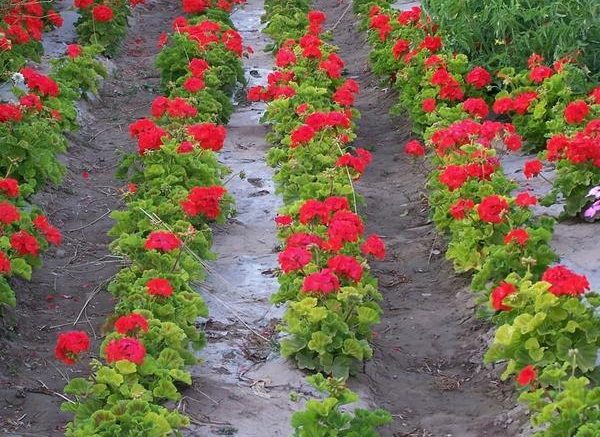

Planted on a flower bed
Site selection and land preparation
Garden geranium grows well in well-lit places, but it will also feel great in places shaded by other shrubs.
Outdoor garden geranium does not impose any special requirements for the composition of the soil - the main thing is that it is well-drained and breathable.
The site for planting must be dug up a few days before planting. Rotted peat, compost and some sand must be added to the soil.
Landing
The process of planting geraniums step by step:
- The planting hole must be dug 15-20 centimeters deeper than the length of the roots of the seedling.
- Lay a layer of expanded clay, gravel or small stones at the bottom of the planting hole.
- Pour a layer of nutrient mixture in the form of a slide on the drainage layer.
- Place the plant vertically, spread the roots well over the entire surface of the earth.
- Sprinkle with garden soil and lightly tamp the soil around the stem.
- Water the bush well, and mulch the ground around.
- When planting young shoots, it is worth adhering to a distance between the bushes of at least 40 centimeters for tall varieties and at least 25 cm for undersized ones.
Important! After planting, young seedlings must be shaded from active exposure to sunlight for several days and watered well.
Geranium propagation
Garden geraniums propagate very easily by growing seedlings from seeds.
Growing from seeds
Planting seeds and growing seedlings step by step:
- Collect fresh geranium seeds or buy ready-made ones at a flower shop.
- Sow in a seedling pot filled with nutritious soil consisting of peat and sand.
- Water the plantings and cover with cling film.
- Provide an air temperature of at least +25 degrees and timely watering.
- When the shoots appear, the temperature must be lowered to + 20-22 degrees.
- When two or three true leaves appear, the plants must be transplanted into separate pots.
- It is possible to land on the street only when the flower gets stronger and grows up to 10-15 cm in height.
Planting technology of perennial garden geranium
Garden geranium, which was planted with the recommendations of professional gardeners, will delight you with flowering in the first year after gardening.
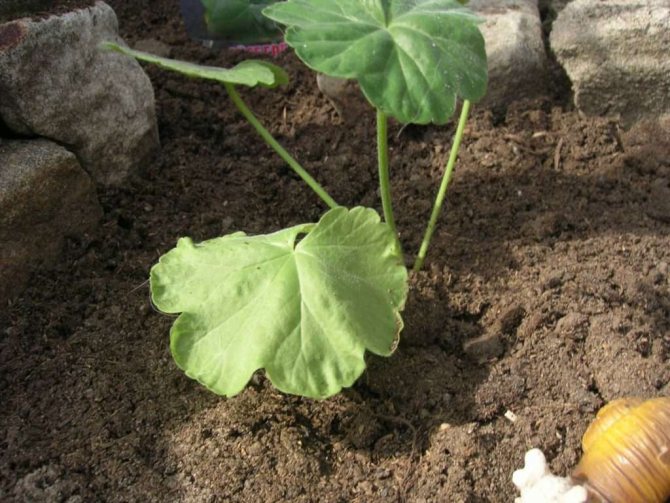

Specialists use a specific technology for planting a crop:
- Geraniums are planted in flower beds in the second or third decade of May.
- Prepare the soil 2-3 days before planting. Beds for pelargonium are dug up, loosened and leveled, after adding rotted manure, sand and slightly acidic peat. It is strictly forbidden to use fresh manure, as it burns the delicate root system of the plant.
- The gardener should also worry about preparing the holes for the seedlings. Geranium is a plant with long roots. That is why the holes are dug 15-25 cm deeper than the root of a young specimen.
- Drainage material is placed in each well. Thanks to him, the roots will not suffer from waterlogging. Broken brick, ceramics, fine gravel or expanded clay are used as drainage.
- Drainage is sprinkled with a mixture of peat and sand with a mound.
- Young seedlings are laid out in the prepared holes and sprinkled with soil mixture.
- The flowerbed is watered abundantly with warm water.
- The surface of the soil is mulched around each specimen to prevent the roots from drying out. For mulching, slightly acidic peat or small sawdust is used.
Geranium is a herbaceous plant suitable for open ground, thrives and grows quickly. Plants wake up early and growth starts with the first rays. The flowering of seedlings is also observed early, and with due attention, flowering can be achieved 2 times a year.
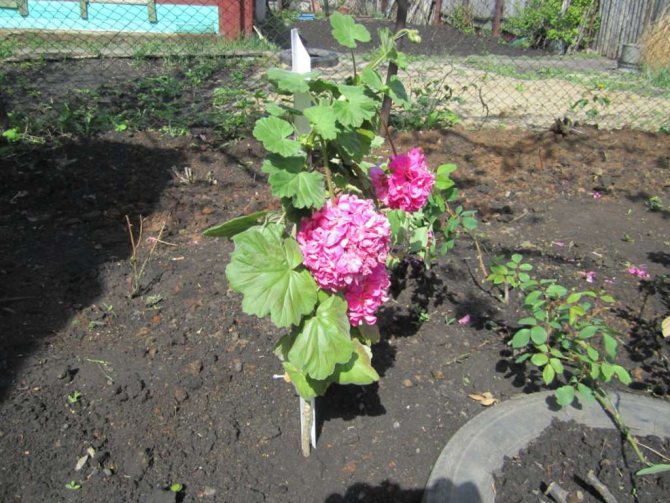

Planting material should be in sunny areas, but without direct sunlight. Areas with a close groundwater table are not suitable.

